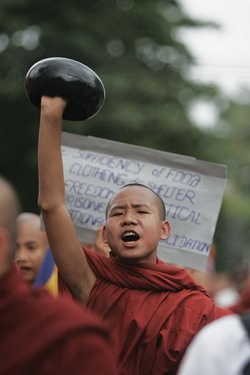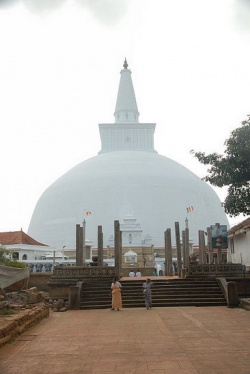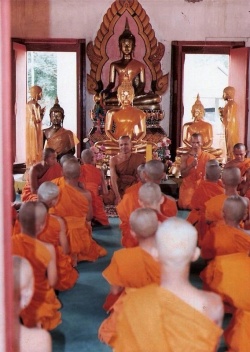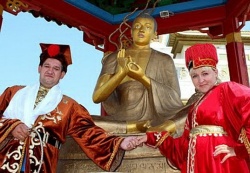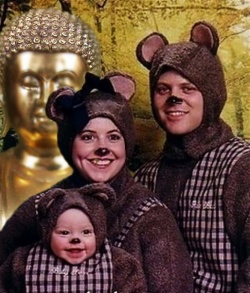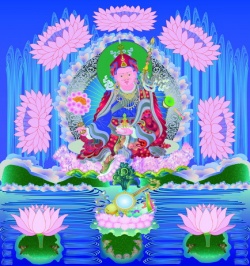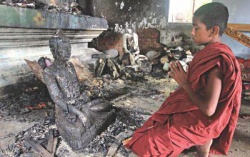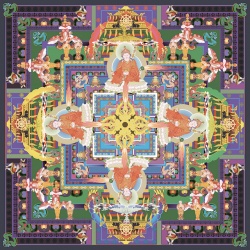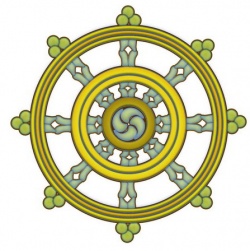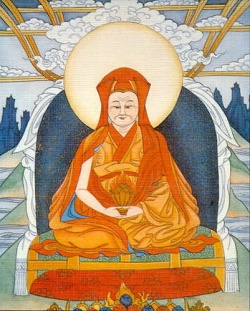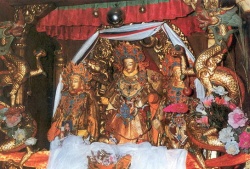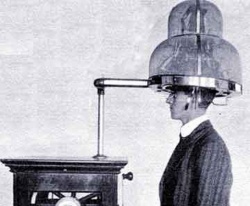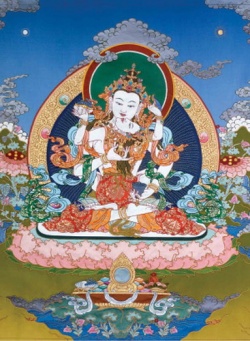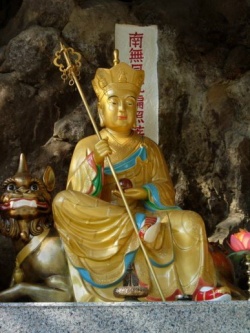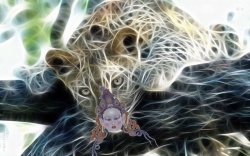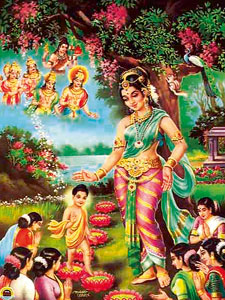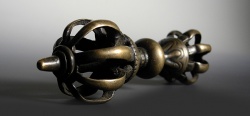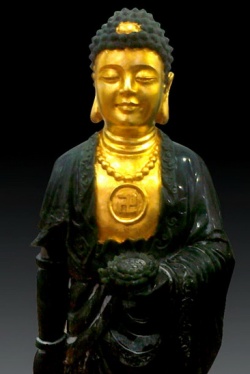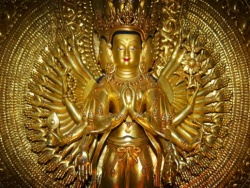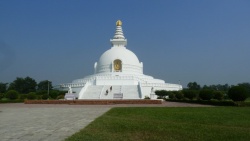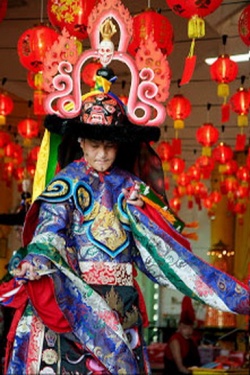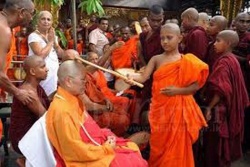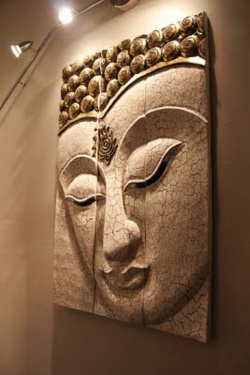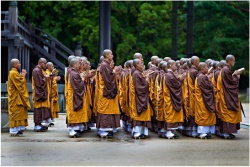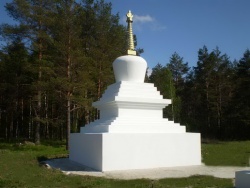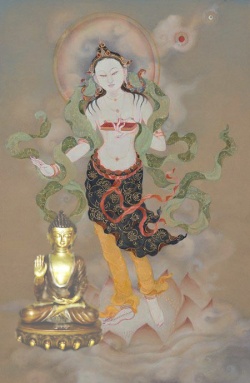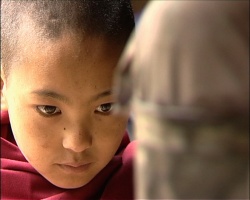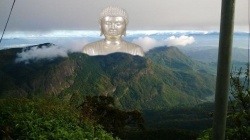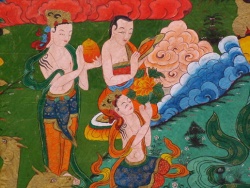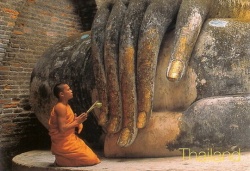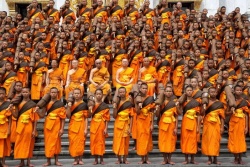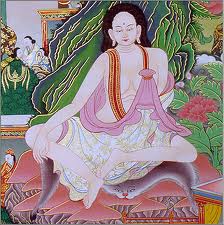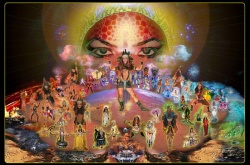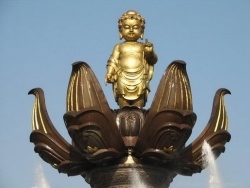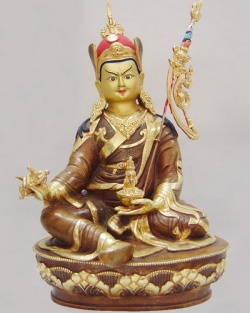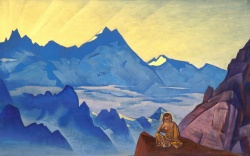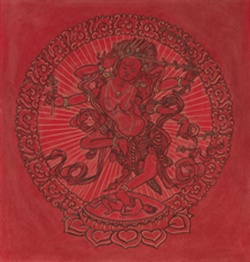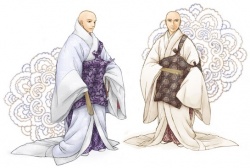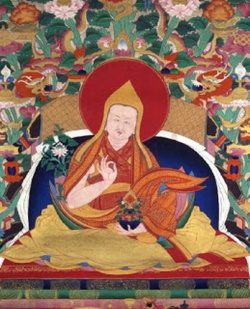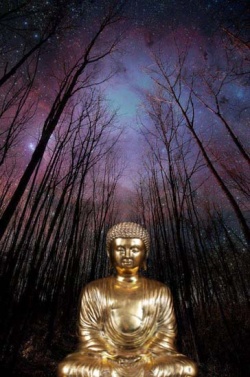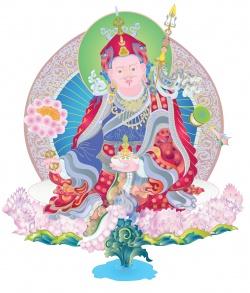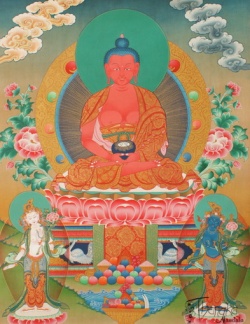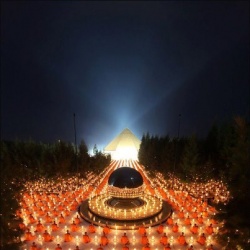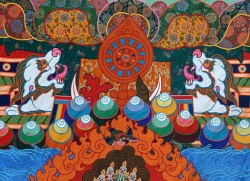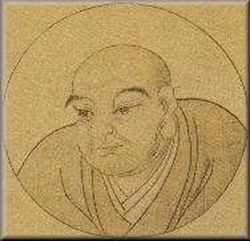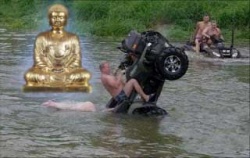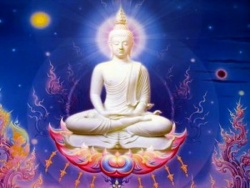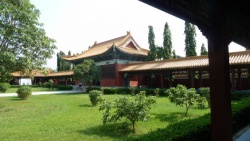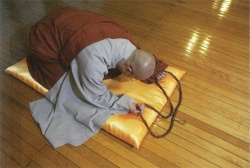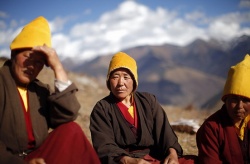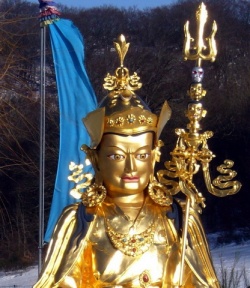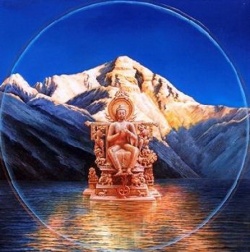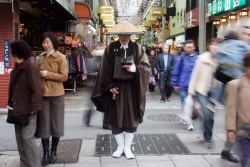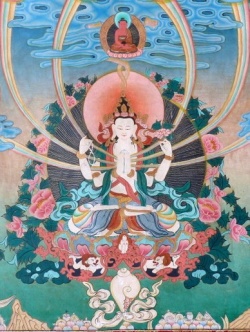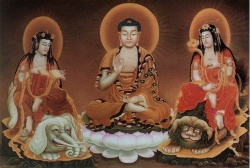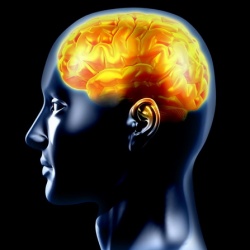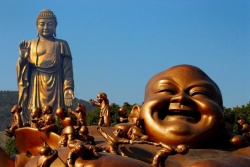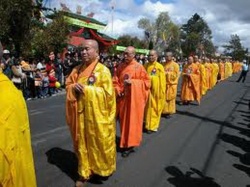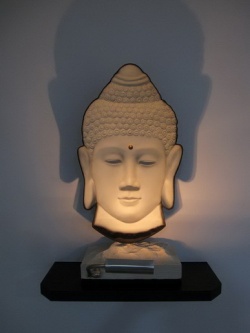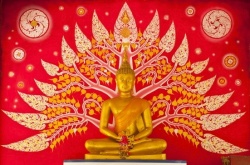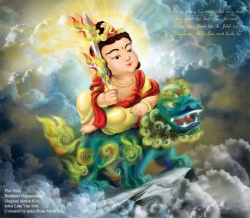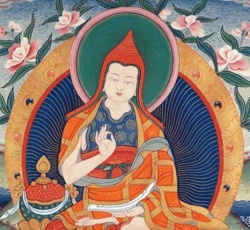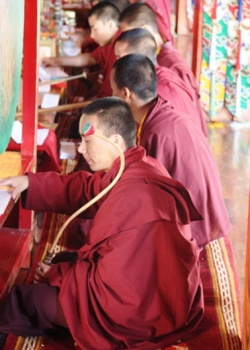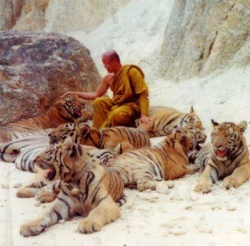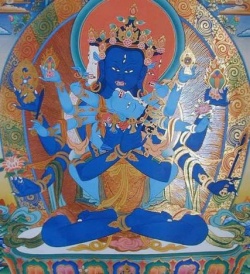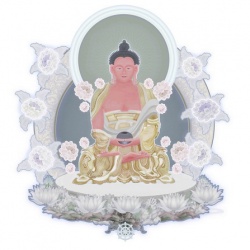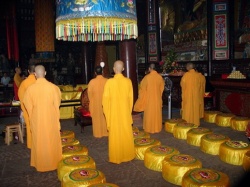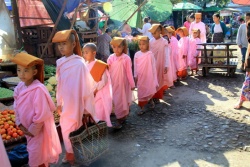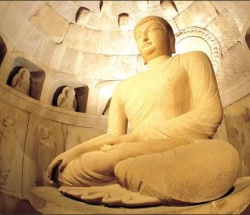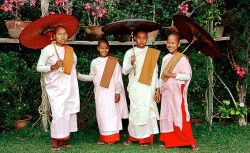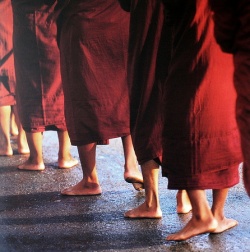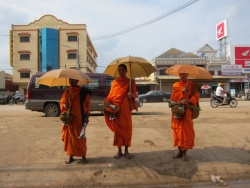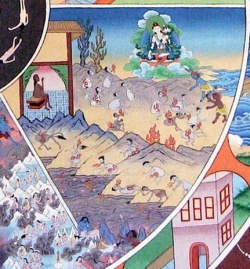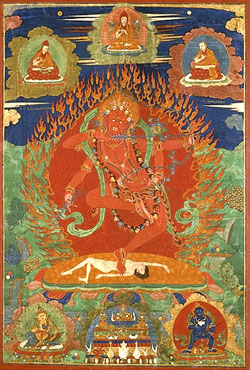Sun and Moon Earrings: Teachings Received by Jigmé Lingpa
by Sam van Schaik
This article was originally published in the Tibet Journal 25.4 (2000): 3–32. It is reproduced here without any substantial changes.
In Tibetan Buddhism the bestowal of textual transmission is an essential prerequisite to the study of most religious texts. The ritual of transmission protects the lineage for a sacred text, ensuring, in principle at least, that it is only passed on to a person who is considered capable of understanding it properly. In most cases the transmission is accomplished by the lama’s reading the entire text in the presence of those who are to receive the transmission. This transmission through reading is known as ljags lung (literally, “transmission by tongue”) or dpe cha’i lung (“book transmission”), but much more often it is simply called lung. When the text is to be used for Vajrayāna meditation practice, the bestowal of initiation (dbang bskur) is also required.[1] Along with the basic transmission, the lama may pass on an oral commentary upon the text, and in this case the ritual of transmission establishes and maintains a formal lineage for one particular way of reading the text.
When, therefore, a Tibetan Buddhist teacher recounts the lineage for the transmissions which he or she has received, he is demonstrating that he has been considered fit to receive them by the teachers who passed them on to him. If he can trace this lineage all the way back to its source, which in many cases will be the Buddha Śākyamuni himself, he can show that the link of approved transmission has never been broken, that is, that every person in the lineage has been approved of as an appropriate vessel for the transmission. Moreover, he can argue that the particular interpretation which he gives to a text is not a personal invention, but is based in tradition.
The importance of the concepts of transmission and lineage in Tibet is shown by the existence of an entire genre of writing in which the author establishes the lineage for each of the texts for which he holds transmission. This genre is called thob yig or gsan yig, literally, a record of what has been received.[2] The most basic format for a thob yig is a list of the texts and initiations which the author has received, for each of which the lineage through which the transmission has passed, from the originator down to the present author, is provided. Perhaps unsurprisingly, most earlier examples of thob yig are from the more scholastically-inclined schools: bKa’-dams-pa, Sa-skya and, later, dGe-lugs. Leonard van der Kuijp has suggested that the emergence of the thob yig as a genre was due to the growing importance which was attached, from the eleventh century onwards, to the concept of the authenticity of texts and teachings which were being circulated in Tibet at this time.[3]
In the thirteenth century one of the early Sa-skya hierarchs, Chos-rgyal ‘Phags-pa Blo-gros rGyal-mtshan (1235-1280), wrote a short thob yig of twenty-three folios.[4] In the fourteenth century Bu-ston Rin-chen-grub (1290-1364) wrote a significantly larger thob yig of 71 folios, and in the fifteenth century Ngor-chen Kun-dga’ bZang-po (1382-1444) wrote a thob yig, more substantial still at 118 folios.[5] Bu-ston’s record is divided thematically into types of text: tantra, sūtra, commentaries, and so on, an arrangement which would become the model for most later thob yigs. Kun-dga’ bZang-po’s text, on the other hand, is divided into seven sections, where each section contains the transmissions which he received from one particular teacher.
Some of the thob yigs add a great deal of information to the basic structure of text and lineage, including discussions of the history and contents of texts, biographical information on certain authors, and quotations from the texts themselves. The best example of this is the thob yig of the Fifth Dalai Lama, Ngag-dbang Blo-bzang rGya-mtsho (1617-1682), the Ganggā’i chu rgyun, which is in four volumes, and was completed in the 1670. His student, the Dza-ya Paṇḍita Blo-bzang ‘Phrin-las (b.1642), also wrote a four-volume thob yig, in which he included biographical material on many Tibetan authors.[6] Another student of the Dalai Lama, the rNying-ma gter ston who founded the monastic centre of sMin-grol-gling in Central Tibet, gTer-bdag Gling-pa (1646-1714) wrote a thob yig in one volume.[7] A little later, the Sa-skya scholar from sDe-dge, Zhu-chen Tshul-khrims Rin-chen (1697-1774), composed a thob yig in two volumes.[8] Most of these figures were involved in the gathering and dissemination of a large bodies of texts, and the composition of a thob yig would have complemented that activity, preserving records of lineages of transmission as well as editions of the texts themselves.
The study of thob yigs
The potential for the application of thob yigs to the study of Tibetan history was noted by A.I. Vostrikov in his Tibetan Historical Literature, although he regarded their importance as marginal in this regard. However, he concluded that:
Nevertheless, it would be unfair to ignore completely the historical importance of thob yig-s, for they contain much interesting material not only for characterizing the academic activity of their compilers but also for a history of Tibetan literature and Tibetan traditions in general.[9]
As Vostrikov suggested, the thob yigs are useful historical documents which can be drawn upon for biography and textual history. They tell us about the education of the author and the identities of all of his major teachers, as well as most of the minor ones, since in the Tibetan tradition it is rare for a teaching not to include some form of transmission. But more than this, they offer some biographical information about every figure who appears in the lineages, giving us at least one of their teachers, one of their students, and one text or collection for which they held the transmission. Furthermore, a thob yig allows us to trace the movement of particular editions of texts from person to person, and thus to locate where two or more editions may come together, or where a new edition might appear.[10]
More recently, Western scholars have begun to draw on the historical material contained in these documents. Alex Wayman has published an analysis of the structure of the Dza-ya Paṇḍita’s thob yig, and Leonard van der Kuijp has traced the transmission of the Pramāṇavāda using several thob yigs. Other scholars, most notably David Jackson, have begun to utilise the thob yig literature in general historical studies.[11] Nevertheless, there has as yet been no attempt to produce an annotated translation of a thob yig text.
‘Jigs-med Gling-pa
Rig-’dzin ‘Jigs-med Gling-pa (1730-1798) is well-known as the treasure-revealer (gter ston) responsible for the popular Klong chen snying thig treasure cycle, and as the author of a long work on the tenets of the Buddhist path according to the rNying-ma school, the Yon tan rin po che’i mdzod. Born in southern Central Tibet, he left home at the age of six to join the monastic community of dPal-ris, a rNying-ma monastery. He was not recognised as a person of any importance, and so did not receive an intensive course of education. As he relates it in his autobiography, this was in spite of his strong inclination to study:
I began with the study of grammar, and whatever vajra topics I came across, such as the Conqueror’s scriptures and the treatises which clarify their intention, texts on conventional definitions and instructions on the true nature. Although I seized on them with veneration, apart from a few good imprints which inspired me to study in the brightness of day and under lamplight, I had no opportunity to increase my knowledge in a relationship with a teacher, even for a single day. Then in dPal-gyi bSam-yas mChims-phu, I met three times with the wisdom-body of Klong-chen-pa, and through being blessed with various auspicious symbols, my karmic connections were awakened from out of The Great Perfection.[12]
It is evident, however, that ‘Jigs-med Gling-pa did receive some textual transmissions in his youth, including Klong-chen-pa’s (1308-1363) Sems nyid ngal gso and the thirteen-volume treasure cycle Bla ma dgongs ‘dus of Sangs-rgyas Gling-pa (1340-1396).[13] At the age of 27, ‘Jigs-med Gling-pa entered into a three-year retreat, in the course of which he experienced the visions in which the Klong chen snying thig was revealed to him. After completing that retreat he immediately entered into another three-year retreat, during the course of which he had the three visions of Klong-chen-pa, alluded to in the passage above, which gave him the confidence to write down the Klong chen snying thig treasure texts and to compose works of his own on the subject of rDzogs-chen meditation. After completing this retreat, ‘Jigs-med Gling-pa moved into a monastery, which he named Tshe-ring-ljongs Padma ‘Od-gsal Theg-mchog-gling, which had been constructed for him by disciples who had gathered during the years of his retreats. He lived here, not far from dPal-ri monastery and his birthplace, for the rest of his life, leaving only to make occasional visits to other monasteries such as Sa-skya, where he often received transmissions. He died in 1798, having just made the journey to ‘Bri-gung, where his son was to be enthroned as the new head of the ‘Bri-gung bKa’-brgyud.
The thob yig of ‘Jigs-med Gling-pa, the Nyi zla’i rna cha “Sun and Moon Earrings”, is brief enough to present here in a full translation, something which, as far as I know, has not been attempted for any thob yig before. Along with its importance for biography and textual history, which I will come to shortly, this translation may serve as an introduction into the style and conventions of the thob yig. The thob yig is perhaps best seen as a series of entries, each entry headed by the name of a text, or collection of texts. Where the text is not scripture considered to originate with a Buddha the name of the author is also given. After this the lineage is listed, beginning, in the case of the sūtras, with the Buddha Śākyamuni, and in the case of the tantras, with a dharmakāya buddha. For the rNying-ma tantras which appear in ‘Jigs-med Gling-pa’s thob yig this is usually Kun-tu bZang-po (Samantabhadra) or rDo-rje ‘Chang (Vajradhāra). Where texts do not have this status, the lineage follows on from the author of the text. In all cases the lineage ends with the name of the teacher from whom the author received the transmission.[14] Often, alternative lineages are given: a lineage may split into two or more lines of transmission and then come together again in one lineage-holder, or split and be received by the author from two or more teachers.
One difficulty in reading a thob yig is the common practice of abbreviating names. However, this need not present a major obstacle. In ‘Jigs-med Gling-pa’s thob yig a name is given in full the first time it appears and usually abbreviated thereafter, the abbreviaton following the usual Tibetan convention of dropping the second and fourth syllables of a name, so that, for example, Padma Phrin-las becomes Pad-phrin. The use of variant names is, as with most Tibetan historical works, a more serious obstacle, alleviated somewhat in this case by the knowledge we have of ‘Jigs-med Gling-pa’s teachers, on whom a good deal of research has been done.[15]
The construction even of a brief thob yig must have involved a considerable effort of research for the author, who would need to turn to earlier thob yig literature to fill in the gaps in the lineages which he was attempting to give in full. Sometimes ‘Jigs-med Gling-pa simply refers the reader to earlier thob yigs, usually those of the Fifth Dalai Lama and gTer-dbag Gling-pa.[16] The Fifth Dalai Lama, gTer-bdag Gling-pa and his brother Lo-chen Dharmashrī (1654-1717) were active in collecting all the rNying-ma transmissions they could find, and the transmissions originating from the latter two came to be known as the sMing-grol-gling bka’ ma, after the large monastic centre which they founded.[17] Much of ‘Jigs-med Gling-pa’s thob yig represents an extension of the sMing-grol-gling transmission into the late eighteenth century. The lineage of the other major central Tibetan monastery, rDo-rje-brag, also appears frequently in the thob yig, including within it the throne-holder Padma ‘Phrin-las (1641-1717)[18] and once again in many cases the Fifth Dalai Lama. Also represented is the monastery of Thang-’brog, which was established by rTse-le sNa-tshogs Rang-grol (b.1608), who also appears in a number of transmission lines in the thob yig.
‘Jigs-med Gling-pa’s thob yig is 13 folios in length, and is divided into four main sections:[19]
(i) the rNying ma rgyud ‘bum (ff.2b-6b, pp.868-876): the scriptures of the early translation period, subdivided thematically into the triad of sūtra, illusion, and mind (mdo sgyu sems). This seems to be roughly equivalent to the three highest rubrics of the rNying-ma school’s nine-vehicle classification: mdo indicating the scriptures of anuyoga, of which the most important is the dGongs pa dus pa’i mdo, sgyu indicating the scriptures of mahāyoga, of which the most important is the sGyu ‘phrul gsang ba snying po tantra, and sems referring to the scriptures of atiyoga, rDzogs-chen, the earliest known of these being a group of eighteen texts those belonging to the “mind class” (sems sde).
One of ‘Jigs-med Gling-pa’s best-known achievements is his work on a new edition and catalogue of the rNying ma rgyud ‘bum. Beginning in 1771 and finishing in the summer of the following year, ‘Jigs-med Gling-pa worked, with assistants, on a new edition of the collection, carving new printing blocks and expanding the edition compiled by Ratna Gling-pa, while at the same time writing a catalogue of the rNying ma rgyud ‘bum.[20] The thob yig below must be considered a companion to this catalogue, which includes lineages for individual textual elements of the rNying ma rgyud ‘bum, as well as biographies of some of the central figures in the transmission of the texts.
‘Jigs-med Gling-pa’s new edition of the rNying ma rgyud ‘bum became the basis for the sDe-dge edition published by the dGe-rtse incarnation ‘Gyur-med Tshe-dbang mChog-grub in the late eighteenth century, considered to be the best rNying ma rgyud ‘bum, the culmination of the work of the great editors Ratna Gling-pa and gTer-bdag Gling-pa.[21] ‘Jigs-med Gling-pa’s other work of collection and preservation, a kind of appendix to his work on the rNying ma rgyud ‘bum, was the ‘Phur pa rgyud lugs, a collection of the extant Vajrakīla texts, which he had completed by 1783, when he gave the transmission for it at Sa-skya monastery.[22]
The thob yig of ‘Jigs-med Gling-pa is an important source of information for the history of the rNying ma rgyud ‘bum, showing the lineage through which he received the transmission of this collection, as well as the other scriptural texts with which he supplemented it for his own edition. It also tells us that ‘Jigs-med Gling-pa possessed a catalogue of the collection, a text which has not previously been noticed, so far as I know: the dKar chag snga ‘gyur bstan pa mi nub pa’i rgyal mtshan of the third Padma Gling-pa incarnation Tshul-khrims rDo-rje (1598-1669), which he mentions briefly in the rNam thar in connection with his own work on the rNying ma rgyud ‘bum. [23]
(ii) Klong-chen-pa’s works (ff.6b-8a, pp.876-879): this includes all of the major works of the great rNying-ma scholar, with the notable exception of the Rang grol skor gsum. ‘Jigs-med Gling-pa divides this account into the “ordinary” transmission, that is, the standard reading transmissions (lung), and the “extraordinary” transmission, which refers to his three visions of Klong-chen-pa.
(iii) bKa’ brgyad and gter ma texts and collections (ff.8a-11b, pp.879-886): the transmission of the bka’ brgyad, the collection of sādhanas for eight deities which are a fundamental part of the early translation corpus. Versions of this collection exist in ordinary lineages (bka’ ma), as well as a number of gter ma lineages. ‘Jigs-med Gling-pa received a transmission in which both gter ma and bka’ ma lineages had been brought together by mNga’-ris Paṇ-chen (1487-1542). All of the other texts and collections of texts in this section are revealed treasures, including those attributed to the most important early treasure revealers, Nyang-ral Nyi-ma ‘Od-zer (1124-1192) and GuruChos-kyi dBang-’phyug (1212-1270), as well as many from later treasure revealers including Ratna Gling-pa (1403-1479), and contemporaries such as Thugs-mchog rDo-rje and Dri-med Gling-pa.[24]
(iv) Texts from the “new” (gsar ma) schools (ff.11b-12b, pp.886-888): The Sa-skya sādhanas are well-represented with the cycle of “The Thirteen Golden Dharmas of Sa-skya” (sa skya’i gser chos bcu gsum). The dGe-lugs-pa also have a strong presence here with the collected works of the second and fifth Dalai Lamas. ‘Jigs-med Gling-pa also received the encyclopaedic work of Bo-dong-pa (1375-1451), the De nyid ‘dus pa. There is little representation of the bKa’-brgyud schools, although two figures who have strong links to both Karma bKa’-brgyud and rNying-ma are to be found here: rTse-le sNa-tshogs Rang-grol (b. 1608), and ‘Ja’-tshon sNying-po (1585-1656). A few popular Mahāyāna texts are included in this section, some or perhaps all of which ‘Jigs-med Gling-pa received during his youth at dPal-ri monastery; they include Nāgārjuna’s Suhṛllekha, Śāntideva’s Bodhicaryāvatāra and Atiśa’s Bodhipathapradīpa.[25]
(v) Other miscellaneous texts (ff.11b-12a, pp.888-889): ‘Jigs-med Gling-pa provides only a rather perfunctory lineage for the texts in this section. Perhaps he was unable to discover the lineage for some of these texts, or considered the texts to be of little importance, or to have to many well-known lineages to include in a short work.
Notably absent from this thob yig is evidence of the study of scholastic subjects such as vinaya, abhidharma, pramāṇa, Madhyamaka and so on, and the number of tantras and sādhanas far outweighs the number of sūtras. This tends to confirm ‘Jigs-med Gling-pa’s statement in the rNam thar, quoted above, that while he read some such texts on his own he received little formal training. ‘Jigs-med Gling-pa makes clear in the conclusion to this text that this should not be seen as a failing. For him it is not the reckoning of the number of scriptural transmissions one has received which is important but the transmission of the blessings of the teacher who comprehends reality itself, the dharmatā. It is the realisation (rtogs) passed down through the lineage which is most valuable:
It is necessary that the holy dharma of realisation exist in the lineage of Supreme Ones, because the dharma which is given in a reading transmission (lung) can be the object of attachment or the mere examination of words. Meditating in solitude having become disillusioned with the distraction of searching elsewhere for instruction is definitely the best.[26]
Translation:
Sun and Moon Earrings
Being the thob yig which chiefly comprises the precious rGyud ‘bum of the early translations, the bka’ ma sādhanas described in the triad of sūtra, illusion, mind (mdo sgyu sems), the mDzod bdun, the sNying tig ya bzhi, and the earlier and later treasure troves.[27]
I prostrate to the glorious vajra-dharma. That which we call “the Vajrayāna of the Old Tradition (rnying ma)” was translated and systematised into the arrangement of the early translations by the dharma-king Khri-srong lDe’u-btsan, his great teacher in the body of long life, Padmasambhava, Bimala mitra), Bairotsana, g.Yu-sgra sNying-po, gNyags Dzanyānakumara; rMa Rin-chen mChog; and the trio of sKa-ba dPal-brtsegs, Cog-ro Klu'i rGyal-mtshan and Zhang Ye-shes-sde, and others.[28]
Even with the new (gsar ma) tantras, there are so many different classifications that when they are examined with sharp faculties it is difficult to determine the definitive one. However, having rejected arrangements made through partiality regarding the dharma, it is correct to say that the the definition of “the early translations of the Vajrayāna” is the threefold collection of sūtra, illusion and mind, and the three yogas. This can be known from the evidence of the stories and chronicles, such as the Deb ther sngon po,[29] of the lineage-holders – firstly gNyags Dzanyānakumara, in the middle, gNubs Sangs-rgyas Ye-shes), and lastly Zur[-po-che Shākya 'Byung-gnas].[30] In fact, we too have assembled a history of the precious rNying ma rgyud ‘bum.[31]
In general, regarding the classes which are enumerated as the definitive classification of the three wheels, one can make references to classifications of the dharma such as “the particular disciple of the Conqueror, the sermon,” or “by the blessings of this teacher”. However, if one fully comprehends the nature of the scriptures, which is like the simile of the Sage’s wisdom and melody in the rGyud bla ma, there can be an infinite number of classifications of the Vajrayāna tantras.[32] Because of this, in the categorisations of previous scholars, one sees many unfamiliar collections and enumerations, and in the old gsan yig one sees the lists of the dharma called “the unbroken transmission of the scriptures” expanded or condensed as appropriate.
1: The rNying ma rgyud ‘bum
Be that as it may, nowadays the transmission from Rig-’dzin Ratna Gling-pa and his son is most well-known, and has become mixed with the river of transmission.[33] The head of the river of teaching was the great chariot of magical emanations from rMa and gNyags. Before the death of rMa, the enlightened activities the eight glorious disciples (slob ma dpal brgyad)[34] and others reached a great extent. The lineages of gNyags, which were transmitted through the gNubs and Zur families, are the Rong tradition, the mChims tradition and the Cog-ro tradition.[35] Together these are known as the gTsang tradition. Later came the Khams tradition, so called because it was taught within Khams, and the dBus tradition, so called because it spread back into dBus, both of which are still present today.[36]
The earlier and later bodies of doctrine, such as the heard transmission of that great instructor in transforming the mind, Bairotsana, which was passed on from the dharma-king Khri-srong, gYu-sgra sNying-po, sPang Mi-pham and so on, as well as synopses such as the tradition which was passed on from A-ro Ye-shes ‘Byung-gnas]],[37] can be briefly summarised thus:
Mahāyoga, where the development stage is the primary teaching,
Anuyoga, which draws primarily on the completion stage,
Atiyoga, the Great Perfection, natureless reality itself. Foremost in the collection of the three yogas are the secret words taught as thod rgal, which distinguish the errors and obscurations of the preceding eight vehicles.
The different routes of the transmissions of the twenty-five great Tibetans,[38] who set out effortlessly the sequence, from the stages of the eighteen marvels of mind up to the tantras of the dharma-protectors,[39] are set out in great detail in the gsan yig of the Fifth Hierarch.[40] Therefore I pass over them here to ease the weariness of writing.
Now, reaching back to the source of the Tibetan river of transmission, [I received] the transmission of the Ratna-pa father and sons (excluding for the rGyud bcu bdun and the two sPros bral don gsal (tantras) from the dharma series Chos dbang rin po che’i sangs rgyas mnyams sbyor because they were not suitable causes for the development of certainty in the dharma, but including the majority of the others):[41]
The dharmakāya, saṃbhogakāya and nirmāṇakāya down from dharmakāya Kun-tu bZang-po, and the transmission of the lamas of the mental, symbolic and verbal transmissions can be seen in the gsan yig of the Fifth, in which the different teachings are strung together like an elegant pearl garland. The transmission of the teacher from Zur is as follows: gNyal-pa bDe-legs-pa, Gra-pa Rog ‘Jam-dbyangs bShes-gnyen, A-ro dGe-ba Chos-dpal rGyal-mtshan, Phyam-dgon-pa bSod-nams bZang-po, gTer-ston Ratna Gling-pa, his sons Tshe-dbang Grags-pa and Ngag-dbang Grags-pa, Ngag-dbag Nor-bu, Nor-bu Yongs-grags, Nor-bu dbang-rgyal, Tshul-khrims rDo-rje, Tshul-khrims dPal-’byor, bsTan-’dzin ‘Gyur-med rDo-rje, Mang-thos-pa Mi-’gyur rDo-rje. Also,[42] there is another line from sPrul-sku Tshul-khrims rDo-rje: dPal-byor Tshul-khrims rGyal-mtshan, bsTan-’dzin ‘Gyur-med rDo-rje, Mang-thos-pa Mi-’gyur rDo-rje and from lCag-zam sPrul-sku bsTan-’dzin Lhun-grub [to myself].
The dKar chag snga ‘gyur bstan pa mi nub pa’i rgyal mtshan:[43]
gSung-sprul Tshul-rdor,[44] Bon-lung-pa Tshul-khrims rGyal-mtshan, O-rgyan Chos-rgyal, Sangs-gling, O-rgyan Don-grub, and from Thang-’brog-pa Padma Rig-’dzin dBang-po to myself.
The rGyud bcu bdun:[45]
As in the succession of bKra-shis mNga’-gsol,[46] then ‘Bri-gung Ratna, Phreng-bo gTer-chen, rGyal-sras Kun-bzang, Rin-chen Dar-rgyas, Phrin-las Lhun-grub, gTer-gling, Khri-rin-rnam,[47] and by Shrīnātha to myself.[48]
The sPros bral don gsal chen mo:[49]
Above the Sovereign Fifth, as on page 206 of volume nga of the gsan yig,[50] then gTer-gling, Lo-chen, Rin-rnam, and by Thang-’brog to myself.
The complete transmission of the ‘Dus pa[51] from the records of the mDo-glan tradition:
Like sGrub-thabs-kyi sMon-mchog,[52] then gTer-gling Khung-bon, Rin-chen rNam-rgyal, ‘Gyur-med Yon-tan, and by Thang-’brog-pa ‘Gyur-med Padma mChog-grub to me. Also: from rDor-brag Padma ‘Phrin-las,[53] gTer-gling Khung-bon, Rin-rnam, and the same from there.
From the writings of Master g.Yung[54] on the sGyu ‘phrul zhi khro:[55] the ten beneficial initiations (phan dbang) of the painted cloth maṇḍala of the preliminary consecration for the disciple, and the five enabling initiations (nus dbang) of the inner body (nang lus) maṇḍala, comprising the fifteen initiations for the peaceful ones. From the writings of sGrol-ma,[56] the empowerment (lan nus) for the maṇḍalas of the inner and outer wrathful ones. From the notes of gNubs-ston Ratnaṣrī, the secret initiation and forceful initiation (shed bdang) of the gSang ba bha ga maṇḍala, and the initiation of inseparable great bliss for the De kho na nyid sems maṇḍala, comprising the eighteen initiations of the wrathful ones. Thus I have obtained the complete transmission of the initiations for both peaceful and wrathful deities:
Teacher Kun-bzang, the five noble regents (rgyal tshab rigs lnga),[57] the three noble princes (rgyal sras rigs gsum), sKal-ldan Dza, the monk Kukurādza, Indrabhodhi, Singharādza, Uparādza, the daughter Gomasa,[58] Slob-dpon sGeg-pa rDo-rje, and by those two to Slob-dpon Sangs-rgyas gSang-ba. Also: from the daughter: King Kukurādza, Ro-langs bDe-ba’i dNgos-grub, rDo-rje bZhad-pa, the King of Za-hor Prabhahasti, Slob-dpon Sangs-rgyas gSang-ba, sGeg-pa rDo-rje, and by the these two to Paṇ-chen Bimalamitra, rMa Rin-chen-mchog, gTsug-ru Rin-chen gZhon-nu, Kye-re mChog-skyong, Zhang rGyal-ba’i Yon-tan, gNubs Sangs-rgyas Ye-shes.
Also: from the King of Za-hor Prabhahasti to Rig-’dzin Padmasambhawa, and in mChims, to the student of those two, gNyags Dzanyānakumāra, from him to Sog-po dPal-gyi Ye-shes, gNubs Sangs-rgyas Ye-shes. Also: the usual students of rMa and gNyags, then Khu-byang Chu-ba-’od, by him to Zhang and by him to gNubs-chen. From gNubs Sangs-rgyas Ye-shes, gNubs Yon-tan rGya-mtsho, gNubs Ye-shes rGya-mtsho, from those two to Nyang Shes-rab-mchog.
Also: from gNubs-chen, So Ye-shes dBang-phyug, by him to Rab-thung, Ra-thung and Kong-btsun, and heard from those three by Nyang Sher-mchog, from him to Nyang Ye-shes ‘Byung-gnas, Zur-po-che Shākya ‘Byung-gnas, Zur-chung Shes-rab Grags, the four heart-sons and eight descendents, sGro-phug-pa Shākya Seng-ge, rTsags-ston Shākya rDo-rje, rTsags-ston Shākya ‘Byung-gnas, Glan rDo-rje ‘Od, Glan bSod-nams rGyal-mtshan, Chos-kyi Seng-ge, Glan Buddhashrī, Glan bSod-rnams mGon-po, sGrol-ma-ba bSam-’grub rDo-rje, Zur-mo dGe-bdun ‘Bum, Zur Shākyamitra, Dharmalakṣa, dKon-mchog bZang-po, rDo-rje bZang-po, Badzra Bidzrayamitashrī, Karmā Guru, Kun-bzang dPal-’byor, Phrin-las Lhun-grub, Chos-rgyal bsTan-’dzin, gTer-gling-pa, mKhan-chen Lotsā, Khri-rin-rnam, bsTan-’dzin rDo-rje, Khri-’gyur-rnam, sGom-ri Orgyan Klong-yangs,[59] and I heard it from him.
Also: sGrol-ma-ba bSam-’grub rDo-rje, sGrol-ma-ba Sangs-rgyas Rin-chen, ‘Gos-lo gZhon-nu-dpal, Lo-chen bSod-nams, Se-ston Rin-chen-rgyal, sPyan-tshab mGon-po, Se Ngag-dbang rDo-rje, dPal-ldan bKra-shis, Se-ston Legs-grub, Nyang rDo-rje Mi-rtog, lHa-btsun Padma Phrin-las, and the same down from gTer-gling.
Also: from Zur-chung Shes-rab Grags-pa, sKyo-byem Lung-pa (this wise lama was the nephew of sKyo-ston Shāka-ye), Dam-pa Ya-se, A-me-sa rDo-rje bDe-chen, dNgos-grub Nam-mkha’ rDo-rje, Shes-rab-’bar, dNgos-’grub-grags, Lhun-po-pa, bShes-gnyen-pa, mKhas-pa Zhang-ston, rDo-rje Rin-chen, Brag-lhag-pa Shes-rab Tshul-khrims, and then the same as down from Rig-’dzin Nam-grags.
In the Zur tradition, restrictions were usually placed on the three profound initiations, and so the ritual practices (phyag len) were sometimes removed. Thus the three profound initiations are to be found in other transmissions. The following transmission down from Dam-pa Ya-se is known as the profound initiation with supports (rten can). There is also the sBas don rnal ‘byor, abridging the gCung stod ya lung mtshal, which is [the initiation) without supports (rten med). I received both in one personal transmission of the reading:
From Dar-rje dPal-grags, Tshe-dbang Rig-’dzin Lhun-po-pa (this was at the age of 300), then like the previous stages down from Dam-pa Ya-se until rJe bShes-gnyen-pa, then Grub-thob Badzrashwara, Badzralakṣa-skye, Ma sKu-mched Ratnatara, mKhas-btsun Sangs-rgyas, mDo-sde’i mTshan-can, Dus-gsum Sangs-rgyas, rNam-rgyal bZang-po, Chos-brgyal bShes-gnyen, Nam-mkha’ dPal-ldan, Nam-mkha’-grags, Se Chos-rgyal dPal-bzang, Me Kun-bzang, Se Ngag-dbang rDo-rje, and the same down from dPal-ldan bKra-shis.
I also have a special transmission from the Great Kun-mkhyen Klong-chen-pa, a potent arrangement of a new ritual for the peaceful and wrathful emanations.[60]
Thob yig of the initiation of the dynamic energy (rtsal dbang) of sems sde:[61]
From the writings of g.Yung-ston rDo-rje dPal-bzang-po,[62] the direct anointment (rgyal thabs spyi blugs) of The Great Perfection, transmission of the initiation of rig pa‘s dynamism in the eighteen mother and son sems sde texts:
Kun-tu bZang-po, The five buddha-families, gSang-bdag,[63] dGa’-rab rDo-rje, the twenty-five scholars (mkhas pa nyi shu),[64] Bairotsana, g.Yu-sgra sNying-po, gNyags Dzanyānakumara, Sogs-po dPal-gyi Ye-shes, gNubs Sangs-rgyas, gNubs Yon-tan mGya-mtsho, gNubs Ye-shes rGya-mtsho, Nyang Shes-rab-mchog, Nyang Ye-shes ‘Byung-gnas, Zur-chen, Zur-chung, sKyo-ston Shaka-ye, sGro-phug-pa, Dam-pa Shāka-rgyal, the father and son teachers (ston yab sras), lCe-ston Zung-nge, Sras-ston bKra-shis Bla-ma, sTon ‘Bum-me, Chos-rje Bla-skyabs rDo-rje, Drin-can mKhas-pa, dPal-gyi Ye-shes, Ma-cig Zur-mo, Zur-haṃ Shāka-’byung, Zur-mo dGe-’dun, Zur Shākya bShes-gnyen, Bra’o Chos-’bum, dKon-mchog bZang-po, Ka˙-thog-pa Badzraratna, rDo-rje rNam-grol, Khyung-tshang-pa Blo-gros dPal-ldan, Karma Guru, Kun-bzang dPal-’byor, Phrin-las Lhun-grub, Chos-rgyal bsTan-’dzin, gTer-gling, Dharmāshrī, Rin-rnam, Padma bsTan-’dzin, ‘Brug sGam-ri Bla-ma and I heard them directly from him.
Also: from Ka˙-thog Badzraratna, ‘Phags-mchog Bya-btang, Sha-mi rDo-rje-rgyal, g.Yu-’brug rDo-rje, gTad-med Longs-grol, Gong-lo gZhan-phan, and the same down from Phrin-las Lhun-grub.
Also, from gTad-med Longs-grol to the king of profound readings and initiations, Nam-mkha’ ‘Jigs-med,[65] and the same down from Phrin-las Lhun-grub.
Also, another way of transmission: Zur-ham Shāka-’byung and Zur-mo dGe-’dun-’bum, Lang-’gro Tshe-dbang rGyal-po, Bla-ma Legs-pa dPal-bzang, Rin-chen rGyal-mtshan father and son, sKyi-ston Tshe-ring,[66] gNyags-ston Chos-rgyal, Rong-pa ‘Od-gsal Rang-grol, and the same down from gTer-gling.
The initiation for the Sangs rgyas mnyams sbyor:[67]
Like the gsan yig above gTer-ston Rin-po-che,[68] then Padma ‘Gyur-med rGya-mtsho, then from both to Khri-rin-rnam, by him to O-rgyan bsTan-rdor, sGom-ri Bla-ma, and by him to myself.
The Yang dag of the bka’ ma transmission:[69]
The gter ston,[70] Padma ‘Gyur-med, Khri-rin-rnam, O-rgyan bsTan-’dzin rDo-rje, and by sGom-ri Bla-ma to myself.
The great cleansing ceremony (spyi khrus chen po) of Na-rag Dong-sprugs,[71] from the initiation manual of Se-ston;[72] the transmission of the preparations (sta god) and preliminary engagements (‘jug pa sngon du ‘gro) for the painted cloth (ras ‘bris) maṇḍala: the vase initiation of Vajrasattva; the rig pa‘s dynamism initiation of Kun-tu bZang-po and the mudra empowerment of the peaceful and wrathful deities:
Kun-tu bZang-po, rDo-rje Sems-dpa’, rNam-par sNang-mdzad, gSang-bdag, King Dza, Kukurādza, Sangs-rgyas gSang-ba, Prabhahasti, Bram-ze Nyi-ma, Slob-dpon mThing-nag, Padma ‘Byung-gnas, Bimalamitra.
Also: Kun-tu-bzang, Phyag-rdor, Kukurādza, Indrabodhi, Shākyaputri, Singharādza˙, Uparādza˙, the daughter Gomade[vi], Hūṃ-kāra, Sangs-rgyas gSang-ba, Bimamitra, and by him to rMa and gNyags, by those two to Dar-rje and Zhang rGyal-yon, and by those two to gNubs-chen, and later by Sog-po dPal-ye to gNubs-chen, then Srung Legs-ston, his son gZhon-nu sNying-po, Zhu bSon-nams Shākya, Zur-po-che.
Also: from gNubs-chen to Yon-tan rGya-mtsho, Ye-shes rGya-mtsho, Nyang Sher-mchod, Nyang Ye-’byung, Zur-po-che, Zur-chung-pa, sKyo Shāka-de, sKyo[73] Phug-pa, Nye-ston Chos-seng, gTsang-nag ‘Od-’bar, Zur Heruka, g.Yung Sangs-rgyas, sKyo gSang-bdag, Zhang-ston ‘Khor-lo, Glan bSod-nams-rgyal, dPal-ldan Chos-seng, Glan Sangs-rgyas-dpal, Glan bSod-nams mGon-po, Zur Byams-pa Seng-ge, and by those two to sGrol-ma bSam-grub rDo-rje, his son Sangs-rgyas Rin-chen, Chos-grags dPal-bzang, Nam-mkha’i rNal-’byor, Se-ston Rin-chen rGyal-mtshan, sPyan-tshab mGon-po, ‘Jam-dbyans Chos-rgyal-mtshan, his son Blo-gros rGyal-mtshan, Byams-pa bZang-po, Nub dGen-pa Shākya, Byams-pa Rin-chen, Padma Phrin-las, gTer-gling, Lo-chen, Khri-rin-rnam, his son Pad-bstan, and I heard it from sGom-ri-pa.
The transmission of the reading for the root tantra of the sgyu ‘phrul, the glorious gSang ba snying po:[74]
The Teacher Kun-tu bZang-po, the saṃbhogakāya buddhas of the five familes, the nirmāṇakāya lords of the three families, gSang-bdag Phyag-na rDo-rje, Litsā Dri-med, King Dza’, King Indrabhodhi, the son Shākyabodhi, the monk Kukurādza, Nāgā rDzun, Padmasambhawa, Slob-dpon Sangs-rgyas gSang-ba, Bimalamitra, gNyags Dzanyānakumāra, rMa Rin-chen-mchog, Gye-re Phyogs-skyong, Dar-rje dPal-gyi Grags-pa, gNubs Sangs-rgyas Ye-shes, sBa-gor Blon-chen ‘Phags-na Yon-tan-mchog, Ge-re [sic] gSal-ba’i Byang-chub, rGya Blo-gros gZhon-nu, mGar Tshul-khrims bZang-po, Tshur Ye-shes dBang-po, Ngan Chos-kyi dBang-phyug, Zhang-mgon-gi Bla-ma, his elder brother Yon-tan ‘Byung-gnas, Slob-dpon gZhon-nu Don-grub, Kun-mkhyen Ngag-gi dBang-po, mKhas-grub Khyab-gdal Lhun-grub, sPrul-sku Grags-pa ‘Od-zer, ‘Khrul-zhigs Sangs-rgyas dBon-po, Chos-rje Zla-grags, Bla-ma Kun-bZang rDo-rje, ‘Bri-gung-pa Ratna, Nyi-zla Sangs-rgyas, Tshe-dbang Maṇi, sNang-mdzad rDo-rje, ‘Brug sGra-bzang-po, Phrin-las Lhun-grub, gTer-ston Rin-po-che, Khri-rin-rnam, and by Shrīnātha to myself.
The book reading for the dPa’ bo’i skyes rabs so bzhi pa’i kha skyong written by Rang-byung rDo-rje:[75]
Ratnabidzaya, and by Thang-’brog-pa to myself.The transmission in accordance with the writings of the lower purificatory initiation (dbang gtsang) of the rGyud mgon legs ldan ljang ston drag po:Kun-bzang, the five buddha-families, Phyag-rdor, King Dza˙, Kukurādza˙, Ro-langs bDe-ba, rDor-je bZhad-pa, Dharmabhodi, Basudhara, gNubs Sangs-rgyas, Yon-tan rGya-mtsho, Had Sher-mchog, Ye-shes ‘Byung-gnas, Zur-chen, Zur-chung, Glan Shākya ‘Dar-nag bSod-nams-grags, ‘Dar-nag Kun-dga’, Jo-btsun Shes-rab-’bar, Hor-nag dBang-sgrog, Chos-skyong-’od, ‘Dar Shākya Byang-chub, ‘Dar Kun-dga’-'od, Bar-ston Blo-gros rGyal-mtshan, sMar-ston Shākyashrī, sMar-ston Buddhadhādza, Shākya-rab, rDor-rgyal bZang-po, from dPangs Chos-kyi rGyal-mtshan and ‘Jam-dByangs bSod-nams, it was heard by dPangs-ston bDe-legs rGyal-mtshan, and from him to Se-ston Rin-chen rGyal-mtshan, ‘Dar Kun-bzang Rin-chen gZhon-nu sTobs-ldan, Byams-pa Rin-chen, sKyi-ston Tshe-ring, Zur Ngag-dbang Phun-tshogs, gTer-gling, Lo-chen, Khri-rin-rnam, from his son and the two in person to sGom-ri Bla-ma and by him to me.
Also: rDo-rje ‘Chang, rDo-rje Hūṃ-dzad, Bram-ze gSal-ba’i rGyan, and the same down from Basudhara.
Also: rDo-rje ‘Chang, Sthiramiti, Dharmabodhi, Basudhara, Grub-thob Rin-chen-rje, sMad-bu Chos-seng, Guru Byi’u Legs-so, Shud-bu rDo-rje Seng-ge, Zhang-ston bKra-shis, Glan Jo-zung, Guru Dhanaka-rgya, lCe-ston bKra-shis, Zur Shākya Seng-ge, Zur Seng-ge dPal-bzang, Zur-ham Shāka-’byung, from those two to Brom-ston Sangs-rgyas Rin-chen, mKhas-grub rDo-rje dPal-bzang, Nam-mkha’i rNyal-’byor, and the same below Se-ston Rin-chen rGyal-mtshan.
Also, the transmission of the four initiations of the mDo mgon legs ldan zhal gcig phyag gnyis pa, including the initiation of the bKa’ gtad gter:
Kun-tu bZang-po, the five buddha-familes, sGrol-byed Thugs-rje’i rGyal-po, the five Eminent Ones (dam pa’i rigs can lnga), King Dza˙, Sthiramati, Dharmabodhi, Basudhara, gNubs Sangs-rgyas Ye-shes, rNa-chung Chos-kyi Seng-ge, mThu-stobs Byi-nu-log, Shud-bu rDo-rje-seng, Zhang bKra-shis, Glan rDor-thung, Dhanaka-rgya, lCe-zub-pa ‘Bum, Zur Shākya Seng-ge, to his son Tā’i Si-tu Seng-ge-dpal, rDor-je Gling-pa, Byang-chub Rin-chen, Chos-rje bSod-nams Blo-rgyal, mKhas-grub Chos-rgyal-mtshan, dPangs-ston bDe-legs rGyal-mtshan, Se-ston Rin-chen rGyal-mtshan, sPyan-tshab mGon-po-zla, Nub-dgon-pa Byams-pa-chos, Thugs-sras Byams-pa Chos-rgyal-mtshan, Ngam-rin mKhan-chen Byams-pa bZang-po, sPrul Shākya rGyal-mtshan, Bla-ma Byams-pa’i Rin-chen, Rig-’dzin Padma Phrin-las, and the same down from gTer-bdag Gling-pa.[76]
2: The Works of Klong-chen-pa
Thob yig of the Three Chariots and Seven Treasuries:
The line of the reading transmission for the Shing rta rnam gsum and mDzod bdun – the turning of the wheel of dharma by the Second Buddha from the mountain-range of Gangs-ri – is divided into two: ordinary and extraordinary.
First, the lake of sound explanation of the general topics (spyi don), the history (chos ‘byung) of the path to buddhahood in our own system, and the explanation of the very essence of the main path:The root text of the Sems nyid ngal bso in thirteen chapters and its commentary, the Shing rta chen mo; the root text of the bSam gtan ngal bso and its commentary, the Shing rta rnam dag; the root text of the sGyu ma ngal bso and its commentary, the Shing rta bzang po; the summary (bsdus don) of these; the division into sections (sa bcad); and the practice instructions (khrid yig): altogether the transmission of the reading for fifteen treatises:
From Kun-mkhyen Chen-po, Khyab-gdal Lhun-grup, Grags-pa ‘Od-zer, Sangs-rgyas dBon-po, Zla-ba Grags-pa, Kun-bzang rDo-rje, rGyal-mtshan dPal-bzang, sNa-tshogs Rang-grol, bsTan-’dzin Grags-pa, mDo-sngags bsTan-’dzin,[77] gNyos-ston Karmā, Badzakṣāra, Samantabhadra, and by him to me.[78] Also: bsTan-’dzin Grags-pa, Padma Phrin-las, Tshul-khrims rDo-rje, and the same after gNyos-ston Chos-rje.
Although there is some disagreement between certain groups about the order of the transmission, it is set down thus in the gsan yig of Bla-ma Gong-mtsho,[79] and because of the existence of the extraordinary close transmission here, I have not questioned this list.
Now, from the mDzod bdun, the sacred writings which are extensive and profound:
The Don gyi dbyings ‘jal ba yid bzhin rin po che mdzod root text in twenty-two chapters, which distinguishes soundly the tenets of ourselves and others, and following that, fathoms the dhātu of ultimate truth by means of the profound scriptures which are for the most part in agreement with the conventional sciences (tha snyad kyi gtsug lag); the extensive commentary, Padma dkar po; and the practice instructions, Zab don rdo rje snying po rnams:
Kun-mkhyen rGyal-ba, lDan-sgom Chos-grags, Dam-ston Nyi-ma ‘Od-zer, Chos-dbyings Grags-pa, bSod-nams dPal-’byor, sMan-rtse-ba sNa-tshogs Rang-grol, bsTan-’dzin Grags-pa, Padma Phrin-las, Tshul-khrims rDo-rje, Gar-gyi dBang-po, gNyos-ston, Badzrakṣara, Thang-’brog sKu-skye, dBon-po sKu-skye, and by him to me.
The Grub mtha’ rin po che mdzod, which which is a clarification of the significance of the distinctions between the vehicles, and in particular is an unsurpassed teaching on the secret meaning of the four philosophies (grub mtha’ smra ba bzhi),[80] including an appendix clarifying the classes of the profound dharma:
The transmission is the same as for the Ngal bso skor gsum, with just these two differences: between Sangs-rgyas dBon-po and Zla-grags, Shes-rab rGya-mtsho; and between mDo-sngags bsTan-’dzin and gNyos-ston Phrin-las, Dam-chos bZang-po.
The intention of the rGyud bcu bdun and the 119 upadesha, which are unsurpassed by all the teachings on true certainty regarding the nine vehicles, is taught [in the Theg mchog mdzod) without mixing it with other scriptures; therefore it has been praised in this way:
In all the treatises of future generations in Dzam-bu’i-gling,
There will be no equal to this Theg mchog;
Therefore this immeasurable treasury of dharma
Is the life-staff of the teachings on the vajra essence.
The Theg mchog rin po che mdzod, possessing twenty-five levels, and the Man ngag rin po che mdzod, employing the meaning of all the deep instructions:
The same as the transmission for the Grub mtha’ mdzod, then from Badzrakṣara: Ratnabidza˙, and by Thang-’brog dBon-po.
It seems that the Theg mchog mdzod was also heard by rJe Bla-ma ['Jigs-med Gling-pa] from Kong-po Kra-ti; therefore there appears to be a line of transmission from Nyi-grags.[81]
The Chos dbyings mdzod in thirteen chapters and its commentary, the Chos dbyings gsal ba gnyis, teaching principally the klong sde:
Kun-mkhyen Chen-po, bDe-legs rGya-mtsho, Bya-bral Chos-rje, Sangs-rgyas dBon-po, Kun-spangs Sems-dpa’, Sangs-rgyas Ye-shes, Sangs-rgyas rGyal-mtshan, lDan-ljong Kun-bkras, sNa-tshogs Rang-grol, bsTan-’dzin Grags-pa, mDo-sngags bsTan-’dzin, and the same down from gNyos-ston Karma, father and son.
The eleven vajra topics, known as the Tshig don nam ‘od gsal mdzod:
The same as before Sangs-rgyas rGyal-mtshan, ‘Jag-stod-pa Rin-chen-grub, gSer-khang-pa Ngag-gi dBang-po, Byams sDings-pa dPal-’byor, rGyal-mtshan, sNa-tshogs Rang-grol, and the same below bsTan-’dzin Grags-pa.
The gNas lugs mdzod in five chapters and its commentary, which, because they teach the natural state as transcendent of words and concepts and the objects of clinging, should definitely be called thod rgal teachings:
Blo-’das Kun-mkhyen Chen-po, bDe-legs rGya-mtsho, Bya-bral Mangala, dBon-po Shes-rab rGya-mtsho, Kun-spangs-pa, Buddhadzanyāna, Buddhadhwadza, ‘Jag-stod-pa Ratna, Guru bSod-rgyal, and the same down from sNa-tshogs Rang-grol.
Another way of transmission[82] of the entire mDzod bdun except the Yid bzhin mdzod commentary:
sMan-rtse, rDzogs-chen-pa bSod-nams Rin-chen, Ngag-dbang Padma, rGyal-dbang bsTan-’dzin, Orgyan dPal-’byor, Kun-bzang rNam-rgyal, the two Phrin-las father and son, and by Rin-chen Thang-’brog-pa.
For more, one can study the gsan yig of the Fifth, in which there are a great many routes of transmission.
The transmission for the commentary to the gSang ba snying po in 10 parts, the Mun sel,[83] is the same as the transmission for the root tantra of the eight sections of the sgyu ‘phrul series, the gSang ba snying po in 22 chapters.
Second, the extraordinary transmission: In glorious bSam-yas mChims-pu, below dGe’u, as a great purification, like a lake of illusion, which turns ordinary sense-perception around, the Second Conqueror showed me his body of wisdom three times. I was inspired by the manifestation of his speech, which perfected the dharma-ocean of the Conqueror’s scriptural transmission into the very essence of adīkadī. I obtained a vase filled to the brim with the blessings of the one taste of the wisdom quintessence, the mental transmission free from being one or manifold, suchness which is the reality of unelaborated realisation. Without any dependence whatsoever upon the names and characterisations of ordinary people, I grasped the close transmission of this sacred reading like a wishing-gem. This reading transmission went through all of the scriptures such as the sNying tig ya bzhi,[84] and brought about the accomplishment of his own teachings. It was also a clarification in the arrangement of the commentary Shing rta chen mo.
The complete reading and initiations for the Bi ma snying tig and Bla ma yang tig:
As in the gsan yig above gTer-gling, then Khri-rin-rnam, Rab-u-chos, and by Shrīnātha.
The way of transmission for the complete reading and initiations for the mKha’ ‘gro snying tig and mKha’ ‘gro yang tig is exactly the same as above. However there are two ways of transmission for the mKha’ ‘gro snying tig; the other is as follows:
The Precious Fifth, Rig-’dzin Padma ‘Phrin-las, Kun-bzang Padma, Kun-bzang ‘Od-zer, and I obtained it from Kra-ti sNgags-’chang.
3: The bKa’ brgyad and the gter ma
The Rab ‘byams dkyil ‘khor rgya mtsho’i tshom bu sgrub pa chen po bka’ brgyad: the tradition of bka’ ma was transmitted in gNubs down from the four learned men (mkhas pa mi bzhi). Then from gNyags-lo Zhon-nu[85] it was transmitted through a series of accomplished siddhas down to mNga’-dbag Nyang-ral.[86] After this, the bka’ ma and gter ma merged into a single river. This is one of the many different ways of transmission according to the gsan yig of the Fifth. Here is the transmission by mNga’-bdag and his descendents, coming through the tight connections of those great beings who received the siddhis:
Kun-tu bZang-po, rDor-sems, rDo-rje Chos, Las-kyi dBang-mo-che, the eight vidyādharas,[87] the Great Master (Padmasambhava) who Embodies All, the eight siddhas of Tibet (bod kyi grub chen brgyad), Khri-srong [lDe'u-btsan] who Embodies All,[88] Nyang Rin-po-che, Kun-dga’ ‘Od-zer, his son ‘Gro-mgon, Nyang Blo-ldan, mDo-sde Seng-ge, Padma dNgos-grub, ‘Jam-dpal Nor-bu, mNga’-bdag rGyal-mtshan, Nor-bu-’phel, Kun-dga’ ‘Od-zer, rJe’u[89] Rigs Nam-mkha’i rNal-’byor, [mNga'-ris] Paṇ-chen Padma dBang-rgyal (here the two traditions of bka’ matransmission and the the gter ma transmission, the bDe shegs ‘dus pa,[90] merged into one river, so this is undeniably the special handing-down (bka’ babs) of everything and a great chariot of all teachings), by him to ‘Bri-gung-pa Rin-chen Phun-tshogs and gTsang-pa Ngag-gi dBang-po, it was requested from both by Tshe-brtan rGyal-po along with the initiation, the sādhanas (bsgrub dbang) and the ritual practices (phyag len), Paṇ-chen Rin-po-che, Legs-ldan, Ratna, Tshe-brtan rGyal-po, Blo-grogs bZang-po, rDo-rje Ye-shes, from those two to Phrin-las Lhun-grub, his son Rin-rnam, and from Shrīnātha to me. Also, the initiation of the peaceful ones and the strong initiation of the arrogant ones: gTer-gling, his son ‘Gyur-rgyam, and the same below Khri-rin-rnam. Also, there are other different ways of transmission for this bKa’ brgyad, such as the transmission from Gung-thang [by] mNga’-ris, the transmission from lHo-brag Guru-pa,[91] the transmission from Nyang-stod brTse-chen, as well as rDzong-lung-pa, Rin-chen sGang-pa, and Zur.
The stages of transmission of the Nyang gter drag dmar bde ‘dus:[92]
Like the gsan yig of the Precious Fifth, then ‘Gyur-med rDo-rje, Rin-rnam, ‘Gyur-med Don-bzang, and by Thang-’brog.
The stages of transmission of the Nyang gter khros nag ma:
Like the gsan yig [of the Fifth] above the great Paṇ-chen mNga’-ris-pa,[93] then Kun-dga’ Lhun-grub, Karmā Guru, mNga’-bdag sPrul-sku, Chos-dbang Kun-bzang, Phrin-las Lhun-grub, gTer-gling, Rin-rnam, Shrīnātha, and by him to me.
The gTer kha ‘og ma’i gsang rdzogs:[94] the enumeration of the scriptures for the complete initiation and reading is as in the gsan yig of the the Sovereign Fifth. The stages of transmission are:
As in that same gsan yig above sMan-lung-pa Blo-mchog rDo-rje,[95] then ‘Jam-dbyangs Legs-bshad rGya-mtsho, then Padma Chos-’byor, ‘Bras-ljongs Rin-spungs, gSang-bdag rDo-rje, lCag-zam-pa bsTan-’dzin Lhun-grub, and by him to me.
The reading for the maṇḍala ritual text (dkyil chog) of sMan-lung-pa, the Gu ru dgongs rgyan, the compilation (lhan thabs) for the sngon ‘gro, the two commentaries (bshad thabs) on the tantra by sMan-lung Mi-bskyod rDo-rje,[96] and the distillation (yang bcud) of the tantra by Shākya-’od.[97] Also, another way of sucession for the lineage of the the root initiation and reading:
The Great Fifth, Pad-phrin, Khams-lung-pa Padma dBang-rgyal, dBon gSang-sngags, and heard from Dar-rgyas.
The transmission for the initiation and reading for the Bla ma gsang ‘dus:[98]
Like the gsang tho above gTer-gling, then Khri-rin-rnam, and by Shrīnātha.
The initiation and reading for the Yang dag of Chos-dbang Rin-po-che:
From the gter ston: five stages to gTer-gling, Thang-’brog-pa, rDzang-kar Dar-rgyas, and heard from him.
The transmission of the knowledge entrustment (rig gtad) and reading for the sNgags rgod log tri, which mixes the two rivers of the earlier and later treasure-troves (gter kha):[99]
Drang-srong Dri-med, Dharma Ashāka, Bram-ze Legs-sgrub, Prabhahasti, Shāntigarbha, Orgyan Chen-po, mNga’-bdag father and son, Guru Chos-dbang, Padma dBang-chen, Yang-ston Sangs-rgyas, gNyan-ston bKra-seng, Chos-nyid Rang-grol, Sangs-rgyas sNyan-dbang, Kun-dga’ bKra-shis, rGyal-sras Chos-rje, Chos-’phags bZang-po, Shākya dPal-bzang, ‘Jam-dbyangs rGyal-mtshan, mKha’-dbyings rDo-rje, rJe Ratna, Chos-rgyal Phun-tshogs, bKra-shis Phun-tshogs, and by those two to Chos-kyi Grags-pa, dKon-mchog Lhun-grub, Rin-po-che Pad-phrin, Kun-bzang Grol-mchog, and by him to me.
Also: from the gter ston, mKhan-po Chos-dpal bZang-po, and in succession from him.
Also: from the gter ston, Ka˙-thog-pa rGyal-ba bZang-po, Sangs-rgyas Ye-shes, mDo-sde rGya-mtsho, dGe-bdun rGya-mtsho, and the same as above below mKha’-dbyings rDo-rje.
Also: from bKra-shis Phun-tshogs, bKra-shis Kun-dga’, Phrin-las Lhun-grub, and the same as before below gTer-gling.
The complete initiation and reading for the complete Grol tig[100] of the lord of the all-seeing lineage (kun gzigs rigs) Phreng-bo gTer-chen Rin-po-che,[101] [882] the Bla rdzogs thugs gsum tshad ma and the Nag po gsum sgril, including the reading for a part of the gSung ‘bum:
The sacred gter ston, rGyal-sras Kun-bzang, bShes-gnyen Rin-dar, Phrin-las Lhun-grub, Badzrakṣara, Ngag-dbang Kun-bzang Padma, Kun-bzang Grol-mchog, and heard from him.
Also: rGyal-sras, dKon-mchog Chos-dbang Grags-pa, sNang-gsal-ba Ye-shes Grub-pa, ‘Bri-gung Chos-kyi Grags-pa, rNal-’byor Ye-shes Phun-tshogs, Me-rag sPrul-sku, Padma Phrin-las dBang-phyug, Ngag-dbang Kun-bzang Padma, and by Bla-mchog Kun-bzang Grol-mchog. Out of the diverse small traditions of transmission, this assemblage of the immortal three kāyas is like an offering of the medicine of enlightenment.
Although there are different ways of transmission for complete initiations and reading of the bKa’ dus bar ba bla ma dgongs ‘dus collected into thirteen large volumes, this transmission, which has the the blessings of having put the teachings into practice, is the very best:[102]
As in the gsan yig above rGod-tshang-ba sNa-tshogs Rang-grol, (Sangs-rgyas Gling-pa, Rol-pa Ye-shes, Bya-khung dPal-ldan Senge, Chos-rgyal [Phun-tshogs], bKra-shis [sTobs-rgyal], bSod-nams rGyal-po, bSod-nams Bla-ma, bSod-nams Rin-chen, Ngag-dbang Padma, ‘Brug-sgra’i mTshan-can, sNa-tshogs Rang-grol) then given by him to bDe-chen Dang-rgyal, Kun-bzang Rang-grol, Thugs-mchog rDo-rje, and from Rig-’dzin Phrin-las to myself.
Also: as in the gsan yig above the Precious Fifth, then Rig-’dzin Padma Phrin-las, Kun-bzang Padma, and by Kun-bzang ‘Od-zer to myself.
The contents of the bKa’ ‘dus phyi ma rig ‘dzin yongs ‘dus,[103]taken from the heart-treasury on the upper floor [of bSam-yas) by mNga’-ris Paṇ-chen Rin-po-che, are as shown on page 88 of volume nga of the gsan yig of the Fifth.[104] From that [cycle], the transmission of initiation and reading for the dGongs pa tshig gsum pa’i rgyud, not including the Tsi’u dmar po cycle:[105]
The same as the gsan yig above the Great Fifth, then Rig-’dzin Pad-’phrin, gNyags-ston Padma dBang-rgyal, dBon Padma gSang-bstan, lCags-zam Rin-po-che, and by him to me.
The Rig ‘dzin sgrub thabs from the sPros bral bde chen ma cycle; the Yang tig gces sgron from the Sindhura che ba; the Drag sgrub gtug pa kun ‘joms; the Thugs rje chen po’i yang tig, plus the notes on the initations and gtor ma texts; the lineage prayer of the Sindhura che ba; the lineage prayer of the Yon tan gter mdzod, plus the practice manual (las byang), arrangement (chos sgrigs) and lineage list (snyen yig); the initiation for the bSam pa lhun grub ma from the bKa’ brgyad gsang ba yongs ‘dus cycle:[106]
The same as the lineage given above.
The transmission of the initiation for the revealed treasure from ‘On-phu sTag-tshang, the Drag po dbu dgu of mNga’-ris Legs-ldan:[107]
From the holder of the teaching to dBang-phyug Rab-brtan, bSod-nams mChog-ldan, Chos-dbyings Rang-grol, Zil-gnon Drag-rtsal rDo-rje, Rig-’dzin Padma Phrin-las, gNyags-ston Padma dBang-rgyal, De-dpon gSang-sngags bsTan-’dzin, lCags-zam-pa bsTan-’dzin Lhun-grub, and by him to me.
The revealed treasures (gter byon) of Rig-’dzin mNga’-ris-pa(108) from mChims-pu: the life entrustment (srog gtad) for the gNod sprin tsi’u dmar po and the complete reading for the rGyud drug:
From the supreme Paṇ-chen himself, ‘Bri-gung Ratna, bsTan-pa’i ‘Byung-gnas, rGyal-sras Kun-bzang, Rin-chen Dar-rgyas, Phrin-las Lhun-grub, Chos-dbyings Rang-grol, Za-hor Kun-mkhyen, Blo-bzang Pad-phrin, sMin-gling gTer-ston, dGe-slong Blo-gsal, rDo-rje g.Yo-med, and by sGom-chen Dharmakīrti to myself.
I also obtained the initiation and reading for the complete rGyal po byas chos shel phreng dkar po in the same way.
The Phyag rdor dregs ‘dul[109] of Las-’brel-rtsal:[110]
Down from the holder of the teaching to gTer-gling, as in his records, and then Lo-chen Chos-dpal, Kun-bzang Padma, and by Kun-bzang ‘Od-zer.
The initiation of the gZa’ rgod of Las-’brel[-rtsal):
Sangs-rgyas Rin-chen sNying-po, Thugs-pa Chen-po, rDo-rje ‘Chang, O-rgyan Padma, Chos-rgyal Khri-srong, Padma-gsal, gTer-ston Las-’brel, rDo-rje ‘Bum, ‘Bring-gi Bla-ma Grags-’od, sKal-ldan rDo-rgyal, Dharmaketu, Chos-kyi Blo-gros, Klong-chen Nam-mkha’, Shākya bZang-po, Zhang-ston, gSang-sngags rDo-rje, bDud-’joms rDo-rje, bKra-shis sTobs-rgyal, Ngag-gi dBang-po, Chos-dbyings Rang-grol, Rig-’dzin Pad-phrin, gTer-gling, Rin-rnam, and by Shrīnātha to myself.
The complete initiation and reading for the Phur pa of Ratna [Gling-pa]:
From gTer-ston Ratna to dBang-chen bZang-po, rDo-rje rGyal-mtshan, Nam-mkha’ ‘Grags-pa, Tshe-bdag rDo-rje, bDud-’joms, Kun-dga’, ‘Jam-dpal (Lung-rigs Kun-dga’ and ‘Jam-dpal rGya-mtsho are the same), Ngag-dbang Grub-pa, dGe-slong rNam-rgyal, and him to myself.
The Dam can of Ratna [Gling-pa]:
gTer-ston Ratna, his son Tshe-dbang, Ngag-dbang, Las-’phro, ‘Bri-gung Ratna, Sangs-rgyas Phun-tshogs, Nor-bu Chos-brtan, Phrin-las Lhun-grub, gTer-gling, Rin-rnam, Gunashrī, ‘Gyur-med Chos-dbyings, Thang-’brog, and I obtained it from him along with the reading transmission.
The complete initation and reading for the gShin rje tshe bdag:
Above gTer-gling, as in his record of the transmission (brgyud yig), then Rin-rnam, Shrīnātha, myself.
Yang bzlog me’i spu gri:[111]
Above ‘Bri-gung Ratna,[112] as in the prayer to the lineage (brgyud ‘debs), then rJe-btsun Pradzanyā, Karmā rGyal-sras, bShen-gnyen Rin-dar, Phrin-las Lhun-grub, Badzrakṣara, Ratnadzaya, and by Shrīnātha.
The transmission of Ki kang rlung sgrub ngag ‘don including oral instructions (zhal shes) in two parts:
Transmitted from Byang-bdag,[114] Thugs-mchog rDo-rje, rJe Theg-gling, myself.
The rGya can[115] of the Precious Fifth:
From himself to gTer-gling and from him to several people including Bla-ma bDe-chen dBang-phyug, then sPos-’dzin Lhun-rgyam and many others, then from the second Gla-rnying dGe-slong Klu-sgrub to Thang-’brog-pa, from whom I received the complete initations and reading of the root text of the rGya can. This also includes various supplemental texts (lhan thabs) by the two lamas (bla ma rnam gnyis).
The Byang gter thugs sgrub:[116]
In succession from the gter ston to Rig-’dzin Pad-phrin, then Kun-bzang Padma, Kun-bzang ‘Od-zer, myself.
The Karmā guru of dBang-po’i sDe:[117]
In succession from the gter ston down to the Great Fifth, then gTer-gling, dGe-slong Klu-sgrub, Thang-’brog-pa, myself.
The Phyag mo zab rgya of bsTan-gnyis Gling-pa:[118]
Succession from the gter ston: Chos-mdzad, [119] Chos-lhun, Chos-rje, Ye-grol, Mang-thos dGe-dar, Padma dBang, sKyi-ston, dPon-slob Yar-’phel, Thugs-mchog rDo-rje, and by him to me.
dKon mchog spyi ‘dus:[120]
The transmission in sucession from the gter ston: rGod-tshang sNa-tshogs, bDe-chen Dar-gyas, [121] Kun-bzang Rang-grol, Thugs-mchog rDo-rje, and received by me from rJe Theg-gling.
The Ma ning of ‘Ja’-tshon [sNying-po], in the lHa-btsun-pa transmission:[122]
sNgags-’chang Rang-grol, Thang-’brog mKhan-po, and from dBon-po sKu-skye Phrin-las mChog-grub.
The sNyan brgyud gtsug rgyan nor bu and Tshe dpag med dngos sgrub kun ‘dus of ‘Ja’-tshon [sNying-po]; also the rTa phag[123] and gZa’ dbang from the latter:
sMin-gling lHa-chen, gTer-ston, Rin-rnam, and from Thang-’brog.
Many texts from Chos-rje Gling-pa including the Yang phur,[125] Khro nag skor, Gur drag,[126] rTsa gsum ma dril sgrub, Bla ma rig ‘dzin gyi gnas lung, Phyag dor seng sgrog,[127] and Chos bdag bam chang sel ba:
The gter ston, Nam-rdor, Chos-’phel, and by Thang-’brog to myself.
The Phur pa of Rwa-ston,[128] the gTer chos of Thugs-mchog rDo-rje,[129] and the gTer chos of rJe Theg-gling:[130]
Heard from [the gter stons] themselves.
The Yang ti nag po longs rdzogs of Dung-mtsho Ras-pa:[131]
Transmitted from lCung-ri; heard from Dharmakīrti.
The initiation and reading for the Thugs rje chen po rgyal po lugs:
gTer-gling, Rin-rnam, and by Shrīnātha to myself.
The rTa mgrin gsang sgrub:
gTer-ston rGya-gong-ri-ba, the Great Fifth, gTer-gling, Rin-rnam, and by Shrīnātha.
The life-force initiation (srog dbang) of the Dam can sde bdun:
The same as the lineage for the snying thig above Kun-mkhyen Chen-po, then bDe-legs rGya-mtsho, Ma-ti Ma-sgal, Yon-tan-dpal, sPrul-sku bSam-rgyal, Nam-gzhon, mKha’-klong Yangs-pa, sMan-rtse-ba Blo-rgyal, sNa-tshogs Rang-grol, bsTan-’dzin Grags-pa, rGyal-sras Kun-bzang, bShen-gnyen Rin-dar, Phrin-las Lhun-grub, gTer-gling, Rin-rnam, Thang-’brog, and by Rig-’dzin Phrin-las.
The permission for dMag zer mo:
From Paṇ-chen Chos-rgyan, Dam-chos rNam-rgyal and by sGom-chen Dharma.
The life entrustment (srog gtad) and oblation (gsol ka) for g.Yu sgron ma:[132]
From dGe-slong Blo-gsal, rDo-rje g.Yo-med and by sGom-chen Dharma.
The Chos dbang gter byon brtan mang cu gnyis including the reading and life entrustment, the sMin-gling gTer-ston transmission:
dGe-long Blo-gsal, rDo-rje g.Yo-med, and by Dharmakīrti.
The Dam can of Las-’phro:[133]
From Las-’phro, his son ‘Od-gyam, the Fifth, Padma Tshangs-dbyangs, and by Thang-’brog.
The Dam can of sTag-sham,[134] the Chos-gling transmission:
Bla-phyag, Chos-sprul, and by Thang-’brog.
4: Collections from the New Schools
gSar-ma cycles
The initiation of[135] the Lū-yi-pa bDe mchog,[136] the ‘Dus pa of the ‘Phags tradition[137] and the ‘Jigs byed of the Rwa tradition:[138]
The same as the gsan yig above the Precious Fifth, then from him: Blo-bzang mKhas-btsun, Dus-’khor dPon-slob, and from sGom-chen Dharma to myself. I also obtained the reading for the bDe mchog root tantra.
The complete book reading for the famed Sa skya gser chos,[139] along with a personal teaching (zhal shes) displaying non-conceptually, by means of the blessings of the Sindhura maṇḍala, the mKha’ spyod skor gsum[140] of the Tshar tradition.[141] The permissions for sPyod ‘jug,[142] Slob spring,[143] bShes spring and gTsug tor rnam rgyal ma;[145] the permissions and reading for gDugs dkar,[146] gNas bcu, sGrol dkar yid bzhin ‘khor lo,[147] dByangs can ma dkar mo,[148] bCu gcig zhal,[149] Byag rdor gos sngon, ‘Byung ‘dul, the Jam dkar of the Mati tradition,[150] Yum chen mo,[151] So sor ‘brang ma,[152] Dzam lha dkar po,[153] and the Zhang blon rnams of Grwa-pa.[154]
The Precious Fifth, The 18th Zha-lu-pa,[155] rMo-rong, dBon Rin-po-che, and by Dharmakīrti to myself.
The Dam-ring mKhan-po transmission of the permission for rNam ‘joms,[156] Grwa lnga[157] and rNam sras ser chen rnams:[158]
Ngag-dbang Rin-chen, and obtained from sGom-grags-chos.
I also obtained the volumes of the bKa’ ‘bum of rGyal-sras Thogs-med in the same way.[159]
From the gSung ‘bum of rJe dGe-’dun rGya-mtsho,[160] the Phur drag of his tradition (rang lugs) and Tshe dbang grub rgyal:
From dGe-slong ‘Jam-grags, Byang-rtse dPon-slob, and by Dharmakīrti to myself.
I obtained the rGa lo’i mgon po phyag bzhi and Shangs mgon phyag drug in the same way.
From the rTa mchog rigs sgrol ma mngon byung gi rgyud:[161] the transmission of the permissions for the deities (thugs dam) in the collection of Klu-sgrub,[162] brought to Tibet by gNyan-lo and known as the gNyan sgrol yan lag, and the reading for the mTshan brgya:
sGrol-ma, Klu-sgrub, Palimahabi, Sangs-rgyas Ye-shes Zhabs, Drīpaṃkārabhadra, dPal bDe-ba’i-lha, Dri-med sNgas-pa, Kha-che Rin-rdor, Rin-chen Grags-pa, Senda-ba Chen-po, Ri-sul rNal-’byor-ma, gNyan-lo, Kha’u-pa, brTse-chen, rJe-btsun Grags-pa, Sa-paṇ, Byang-chub-dpal, bDe-ba-dpal, Ka-bzhi Grags-gzhon, bSod-grags, Tshul-’khrims mChog-ston, Sher-rdor, rGyal-bzang, Byang-seng, Shar-chen Ye-grol, Drug-pa Kun-bzang, Zhal-tshab Kun-dbang, dKon-mchog ‘Phel-ba, Ngor-pa dKon-lhun, Thar-rtse Nam-dpal, sGrub-khang-pa dPal-don, bSod-nams mChog-ldan, the Precious Fifth, Phrin-las rNam-rgyal, Blo-gros dBang-phyug, ‘Jam-dbyangs, Nus-rgyan, and by Dharmakīrti, along with the reading for the fourfold maṇḍala.
The transmisson of the reading for: the bKa’ ‘gyur ro cog gi gzungs,[163] the lCags sdong tshe sgrub hrī˙ gcig ma, the bKa’ brgyad chu gtor of ‘A-zha mKhyen-brtse, the Zhang khrom gyi ngag byin rlabs, the ‘Gyur sngags sambhara, the Phreng sngags ru rtsir, the Byams pas dam bcas pa’i gzungs, the gTsug tor dri med and Sor ‘brang snying po rnams.
The same as above from the Precious Fifth.
The Ma ṇi bka’ ‘bum transmitted by the saṃbhogakāya emanation Tshul-khrims rDo-rje,[164] the Gur drag of ‘Brugs-pa Padma dKar-po, the mDo sdud pa, [165] and the gTum mo instructions of the Ras-chung tradition:
Obtained from O-di-karmā.
The reading for the dKyil ‘khor lam bsdus and De nyid ‘dus pa of Bo-dong-pa:[166]
Heard from sByor-rtse sPrul-pa’i-sku.[167]
From the sGrub thabs rin ‘byung:[168] Kurukulle, ‘Od zer can ma, Tshe ring ma ched lnga rnams:
Nyang-re Dor-kong Bla-ma, Dri-bu lHa-ba, by him to Thang-’brog, and by him [to myself].
The gSung ‘bum nang ma rnams of the Fifth[169]
‘Jam-grags, dGe-slong sKal-ldan, sKal-bzang Padma dBang-phyug,[170] and by Thang-’brog.
The four volumes of the gSung ‘bum of rGo-tshang sNa-tshogs-pa:[171]
From rGod-tshang to [sGam-po-pa] bZang-po rDo-rje, dGe-slong Tshul-khrims dPal-bzang, Kun-bzangs Legs-grub, and by Padma Rig-’dzin.
5: Other miscellaneous texts
The readings for: the bKa’ thang shel ‘brag ma;[172] the Thang yig sde lnga;[173] the lHa bzang[174] bde legs kun ‘byung; and from the bDer ‘dus:[175] the Byang bde rnam, the inner accomplishment (sgrub khong), wrathful dances (khro rol), gtor ma exorcism (gtor bzlog), liturgical arrangement (chog khrigs) and practices (lag len); and the Byang rdo rje me phreng rnams from the Tshe bdag:[176]
Khri-rin-rnam, and by Shrīnātha.
The readings for recitations for pure dharma activity (chos spyod), including the Le’u bdun ma, ‘Khor lo ‘bar ba and Byang gter kun bzang mon lam:[177]
Ngag-dbang Kun-bzang Padma, Thugs-mchog rDo-rje, and by Blo-bzang Padma.[178]
The reading for the Thugs rje chen po’i mig ‘byed:
From sKyi-ston[179] to gNas-gsar-pa Wagindra, and by Dharmakīrti.
Byad ‘grol chang khrus:
From sKyi-ston, dGe-slong Blo-gsal, g.Yo-med, and by Dharmakīrti.
gTad rul zangs gling ma:[180]
From sKyi-ston, and by Thang-’brog.
Furthermore, the ‘Brum srung bcud ‘khor of Byis-pa gTer-ston, is one with that transmission.
The reading for the Sha brgya zan brgya:
From dGe-slong Blo-gsal, and by Dharmakīrti.
The reading for the gNam skas gter ma snying gzer nag po:
Ngag-dbang Kun-bzang Padma, Thugs-mchog rDo-rje, and by Kra-ti sNgags-’chang.
The dPa’ bo’i skyes rabs so bzhi pa’i kha skyong, by rJe Rang-byung-pa:
Khri-rin-rnam, and by Thang-’brog.
The gCod gdon tshogs dgu ma of the Karma bKa’-brgyud tradition,[181] the gCod of Ma-cig [Lab-sgron], the gZa’ bcos rin chen phreng ba along with a cremation mantra (spur sngags).
Heard directly from a gcod pa.
Although the scrutiny of what is and what is not a continuous tradition and a class of dharma is correct logical analysis, because the continuous transmission of dharma throughout the three times, from the earliest to the latest, is not composed of anything like the skandhas of perception, feeling and consciousness, where is the true meaning [of transmission) to be found for any of these teachings endowed with the wondrous causes and conditions of teacher, audience and book? Even at the present moment in a line of transmission – like that famous addition to the thirty-four jātaka stories of Aśvaghoṣa after the [story of the bodhisattva) being eaten by tigers – while it is being read out the holy dharma of ultimate truth is present as the singular realisation-transmission of the Conqueror. Therefore, the one from whom the teaching is requested should be able to see the ultimate truth of the reality itself, and have compassion without fixation. Also, the student should have renounced the three faults of the vessel, and the six stains of an impure listener.[182] If such a teacher and student should meet, the circumstances for the entry of blessings will be utterly pure, and the student will see the undeceiving cause and fruit of the accumulations. Thus the faultless connection between teacher and student should be held supreme.
In this last five-hundred year cycle, a person who sees the truth of reality itself has become a rare thing. Yet one who has accomplished generation and completion and possesses bodhicitta is absolutely necessary. Nowadays, when we have come to the dregs of the teaching and [such teachers) are rare, for those who desire to acquire instruction from others, any ordinary person is acceptable for the matter and substance of reading and initiation. Because of this, having developed great strength of mind in the meaning of the teachings, and having been encouraged to listen to teachings, especially the precious rNying ma rgyud ‘bum and the triad of sūtra, illusion and mind, we continually received them in order to strengthen the tradition. It is necessary that the holy dharma of realisation exist in the lineage of supreme seers (mchog gzigs), because the dharma which is given in a reading transmission can be the object of attachment or the mere examination of words. Meditating in solitude having become disillusioned with the distraction of searching elsewhere for instruction is definitely the best.
In the natural course of being guided in the methods of dharma, I trained in the pure vision of all elements. From the perspective of pure vision, the transgression of renouncing the dharma does not exist. Therefore, having renounced obstacle and accomplishment, boundary and perimeter, acceptance and rejection, I had previously spoken a mere seed of what I had listened to. This is the fully detailed elaboration of the correct list of teachings and people.
May there be virtue.
May there be virtue.
May there be virtue.
Bibliography
Secondary Sources:
Mirror: Bradburn, Leslie. 1995. Masters of the Nyingma Lineage. Crystal Mirror Series Volume Eleven. Berkely, California: Dharma Publishing.
Nyingma: Dudjom Rinpoche, Jigdrel Yeshe Dorje. 1991. The Nying-ma School of Tibetan Buddhism: Its Fundamentals and History (2 vols.), translated and edited by Gyurme Dorje and Matthew Kapstein. Boston: Wisdom.
Kaneko: Kaneko, Eiichi. 1982. Ko-Tantora Zenshu Haidai Mokuroku. Tokyo: Kokusho Kankokai.
Goodman, Steven D. 1983. The Klong-chen snying-thig: An Eighteenth Century Tibetan Revelation. PhD thesis, University of Saskatchewan.
- 1992. ‘Rig-’dzin ‘Jigs-med gling-pa and the Klong-Chen sNying-Thig’, in Davidson and Goodman 1992, pp133-207.
Gyatso, Janet. 1998. Apparitions of the Self. Princeton: University of Princeton Press.
Jackson, David. 1996. A History of Tibetan Painting. Vienna: Österreichische Akademie der Wissenschaften.
Mayer, Robert. 1996. A Scripture of the Ancient Tantra Collection: The Phur-pa bCu-gnyis. Oxford: Kiscadale.
van der Kuijp, Leonard. 1995. “Fourteenth Century Tibetan Cultural History VI: The Transmission of Indian Buddhist Pramâṇavâda according to Early Tibetan Gsan-yig”, Asiatische Studien, vol.49, no.4, pp919-941.
Vostrikov, A.I. 1970. Tibetan Historical Literature (trans. Harish Chandra Gupta). Calcutta: Indian Studies, Past and Present.
Wayman, Alex. 1961-62. “Outline of the Thob Yig Gsal Bahi Me Loṅ”, in Indo-Asian Studies, vol.1 (Śata-Piṭaka series vol.31), pp109-117. New Delhi: International Academy of Indian Culture.
Tibetan Sources:
‘Jigs-med Gling-pa
Thob yig: Thob yig nyi zla’i rna cha [Thob yig] (gSung ‘bum vol.V, pp865-890).
rNam thar: Yul lho rgyud du ‘byung ba’i rdzogs chen pa rang byung rdo rje mkhyen brtse’i od zer gyi rnam par thar pa legs byas yongs ‘du’i snyem [rNam thar] (gSung ‘bum vol.IX, pp1-500).
gSung ‘bum: The Collected Works of Kun-mkhyen ‘Jigs-med-gling-pa (Lhasa edition). 9 vols. (Ngagyur Nyingmay Sungrab series, vols. 29-37). Ed. Sonam T. Kazi. Gangtok, India, 1970-75.
gTer-bdag Gling-pa
Zab pa dang rgya che ba’i dam pa’i chos kyi thob yig rin chen ‘byung gnas. Ed. Sanje Dorje. New Delhi, 1974.
Ngag-dbang Blo-bzang rGya-mtsho (The Fifth Dalai Lama)
Zab pa dang rgya che ba’i dam pa’i chos kyi thob yig ganggā’i chu rgyun. 4 vols. Ed. Nechung and Lakhar. Delhi, 1971.
Zhu-chen Tshul-khrims Rin-chen
Record of Teachings Received: The Gsan Yig of Zhu-chen Tshul-khrims-rin-chen of Sde-dge (2 vols.). Ed. Gyaltsen and Lungtok. Dehradun, 1970.
Notes
1] There are a number of other kinds of ritual associated with the Vajrayāna, which may also be included in a thob yig, including “permission” (rjes gnang) and “entrustment” (bka’ gtad).
2] Less common synonyms are gsan tho, a list of what one has received, and brgyud tho, a list of lineages.
3] See Bibliography.
4] Lung dang brgyud pa sna tshogs thob pa’i gsan yig: Sa skya bka’ bum vol.15 (pa), 361b-383a, in The Complete Works of the Great Masters of the Sa skya Sect of Tibetan Buddhism, vol.7. Tokyo: The Toyo Bunko, 1968-69. Chos-rgyal ‘Phags-pa also wrote a shorter, more specific thob yig, entitled Lam ‘bras lam skor sogs kyi gsan yig: Sa skya bka’ bum vol.13 (pa), 65a-69a, in The Complete Works of the Great Masters of the Sa skya Sect of Tibetan Buddhism, vol.7.
5] Ngor-chen Kun-dga’ bZang-po, Thob yig rgya mtsho, in The Complete Works of the Great Masters of the Sa skya Sect of Tibetan Buddhism, vol.9, ff.90a-217a. Tokyo: The Toyo Bunko, 1968. The thob yig of Bu-ston is called Bla ma dam pa rnams kyi rjes su bzung ba’i tshul bka’ drin rjes su dran par byed pa (gSung ‘bum vol.26 (la), ff.1a-71b).
6] Thob yig gsal ba’i me long.
7] Zab pa dang rgya che ba’i dam pa’i chos kyi thob yig rin chen ‘byung gnas.
8] See Bibliography for details of the above.
9] Vostrikov 1970, p202.
10] Guiseppe Tucci touched briefly on the thob yigs and their usefulness in his Tibetan Painted Scrolls (Rome: Libreria dello Stato, 1949), vol.I, pp124-125.
11] See Bibliography for details of these studies. In Jackson 1996, p114 and 203, the thob yig of the Fifth Dalai Lama is utilised in tracing the lineages for systems of iconography.
12] rNam tharp17: lar kho bo cag gi ni yi ge’i brda sprod pa nas brtsams te| rgyal ba’i bka’ dang| |dgongs ‘grel bstan bcos| tha snyad kyi gzhung| yin lugs kyi man ngag sogs rdo rje’i gnas ji snyed pa mthong pa de dag gus pas nye bar blangs te nyin mo’i snang ba dang sgron ma’i ‘od la mjal bar spro ba’i bag chags bzang ba tsam las dge ba’i bshes gnyen dang nyin gcig kyang ‘grogs nas sbyangs stobs kyi blo gros ‘phel ba’i gnas su ma gyur mod| dpal gyi bsam yas mchims phur rgyal ba klong chen pa’i ye shes kyi sku dang lan gsum du mjal zhing brda thabs rten ‘brel du mas byin gyis brlabs pa la brten nas kho bo’i las ‘brel rdzogs pa chen po nas sad pa yin no|
Note there is a similar assertion in Chu zla’i gar mkhan p41.
13] rNam thar pp17-18.
14] The lineages given for gter ma texts may start with a dharmakāya buddha, or merely with the gter ston, perhaps because gter ma cycles almost always include within themselves an account of their own origin and lineage, so that a reproduction of this in a thob yig is not considered essential. Cf. Gyatso, ‘The Logic of Legitimation in the Tibetan Tradition’, History of Religions 33 (1993), pp97-134.
15] Although lists of ‘Jigs-med Gling-pa’s teachers can be found in Goodman 1992 and Gyatso 1998, both are incomplete. A potential source of error is ‘Jigs-med Gling-pa’s use of variant names, abbreviated names, and Tibetan versions of Sanskrit names. I have identified some variant names as belonging to the same teacher using ‘Jigs-med Gling-pa’srnam thar alongside the thob yig. Below is a more complete list of the teachers in the thob yig, with their variant names (but not the abbreviated versions found in the thob yig, which should be self-explanatory):
1. sGom-chen Dharmakīrti or sGom-chen Chos or sGom-grags Chos
2. Shrīnātha (the same as the Grub-dbang dPal-mgon in Gyatso 1998, p289)
3. (gNas-brten) Kun-bzang ‘Od-zer or Kun-bzang Grol-mchog
4. Thang-’brog Padma Rig-’dzin dBang-po or Thang-’brog sKu-skye
5. Thang-’brog dBon-po rGyur-med Padma mChog-sgrub or dBon-po sKu-skye
6. Thugs-mchog rDo-rje
7. Samantabhadra
8. Kong-po (or Kong-smyon) Kra-ti sNgags-’chang Rig-pa’i rDo-rje (also known elsewhere as Kon- smyon sBas-pa’i rNal-byor).
9. lCag-zam sPrul-sku bsTan-’dzin Ye-shes Lhun-grub
10. sGom-ri Orgyan Klong-yangs or sGom-ri Bla-ma or ‘Brug sGam-ri Bla-ma
11. Theg-chen Gling-pa or Dri-med Gling-pa
12. (mTsho-rgyal sPrul-sku) Ngag-dbang Blo-bzang Padma
13. Rig-’dzin Phrin-las
(The following are only responsible for one transmission in the Thob yig)
14. sByor-rtse sPrul-pa’i-sku
15. dGe-slong rNam-rgyal
16. rDzang-kar Dar-rgyas
17. O-di-karma
(Finally, there are two early teachers whom ‘Jigs-med Gling-pa did not include in the Thob yig)
18. Slob-dpon Bon-btsan-pa (rNam tharp16)
19. Dam-chos Blo-gsal dBang-po (rNam thar p19)
16] See bibliography for details. In two cases, but unfortunately no more, ‘Jigs-med Gling-pa gives volume and page references for the thob yig of the Fifth Dalai Lama which match exactly with the reprinted edition.
17] Cf. Mirror, pp270-72, 273-74.
18] Cf. Mirror, pp266-68.
19] My comments and numbering here relate to the version of the thob yig which appears at the end of volume six of the Lhasa edition of ‘Jigs-med Gling-pa’s gsung ‘bum, in the collection of minor works (dpe phran sna tshogs).
20] Cf. rNam thar pp234ff. The catalogue and history is called sNga ‘gyur rgyud ‘bum rin po che rtogs pa brjod pa ‘dzam gling tha grur khyab pa’i rgyan (gSung ‘bum vol.III, pp1-499), and is mentioned in rNam thar p242.
21] Cf. Mayer 1996, pp233-235.
22] Mentioned in rNam thar p319. Located in gSung ‘bum vol.VI. Nyingma I.839: “A new redaction of the (Vajrakīla) transmitted precepts based on the initiation which had been conferred on him by Langcen Palgi Senge in an emanational mandala and the instructions which followed.”
23] C.f. rNam thar p234.
24] See notes to the translation for details.
25] These were received from Dharmakīrti (rNam thar p20).
26] Thob yig p.889.6ff (see translation).
27] This, the full title, is sNga’ ‘gyur rgyud ‘bum rin po che dang/ mdo sgyu sems gsum gyis mtshon bka’ ma’i sgrub phrin/ mdzod bdun/ snying tig ya bzhi/ gter kha gong ‘og gtso bor gyur ba’i thob yig nyi zla’i rna cha zhes bya ba bzhugs//
Some of the terms I have standardardized in translation here are as follows:
reading (transmission)–>lung
transmission–>brgyud
permission–>(rjes) gnang
entrustment–>gtad
initiation–>dbang
scriptures –>chos skad
records–>yig cha
writings–>yi ge
notes–>zur ‘debs
practice instructions–>khrid yig
holder of the teaching–>chos bdag
28] In this translation I have not attempted to standardise Sanskrit and Sanskritized names. I have also retained ‘Jigs-med Gling-pa’s idiosyncracies in his renderings of Sanskrit words. However in my own notes and explanatory glosses I have used standard transcription.
29] By ‘Gos Lo-tsā-ba gZhon-nu-dpal (1392-1481). Translated as The Blue Annals by George Roerich et al., New Delhi: Motililal Banarsidass, 1976.
30] This lineage is described in Nyingma I.599-649.
31] This is sNga ‘gyur rgyud ‘bum rin po che rtogs pa brjod pa ‘dzam gling tha grur khyab pa’i rgyan. It is mentioned in rNam thar p242. The text is in volume III (ga) of the ‘Jigs gling gsung ‘bum.
32] This is a reference to chapter four of the rGyud bla ma (Theg pa chen po’i rgyud bla ma’i bstan bcos, skt. Mahāyānottaratantraśāstra), which explains the way in which the teaching manifests, in dependence on the karma of sentient beings, using the metaphor of a melody (cf. Peking bKa’ ‘gyur, vol.108, ff.69b-70a). ‘Jigs-med Gling-pa is invoking the concept that the dharma appears differently to different beings in dependence on their karma.
33] Ratna Gling-pa (1403-1497): responsible for the original rNying ma rgyud ‘bum. (cf. Nyingma I.793-795, Mirror 197-98.
34] There are eight “glorious” disciples traditionally linked with gNyags Dzanyānakumara. Cf. Nyingma I.605.
35] Biographies from the Rong tradition are given in Nyingma I.650-684.
36] Biographies of the Khams tradition are given in Nyingma I.688-699.
37] This figure, whose dates are unknown but probably 10th-11th centuries, is supposed to have held both an Indian and a Chinese lineage of rDzogs-chen, and to have produced a system in the sems sde class of rDzogs-chen called A ro thun bdun or A ro khrid lugs. Cf. Blue Annals p167; Nyingma p46 n.608; Karmay 1988, p93 n.42.
38] These are the twenty-five disciples of Padmasambhava. Cf. Nyingma I.534-536.
39] 868.1: rmad for med
40] The name gong ma lnga pa could refer to Chos-rgyal ‘Phags-pa (the fifth Sa-skya hierarch) but almost certainly the Fifth Dalai Lama is intended here.
41] The transmission of the rNying ma rgyud ‘bum.
42] Here and below “also” translates the Tibetan yang, the standard way of introducing an alternative lineage.
43] Cf. rNam thar p234.2.
44] Pad-gling gSum-pa Tshul-khrims rDo-rje (1598-1669). Cf. Mirror 238-9; Nyingma I.735 (where he is listed as a figure in the author’s own lineage of the rNying ma rgyud ‘bum), II.68 n.955; Mayer 1996, pp227-230. Also known as the third Padma Gling-pa, this scholar was an important propagator of the rNying ma rgyud ‘bum (he also appears in the lineage for the rgyud ‘bum immediately above). None of the above mentions this dkar chag, but it is likely to have been an important source for ‘Jigs-med Gling-pa’s own work on the rNying ma rgyud ‘bum.
45] rNying ma’i rgyud bcu bdun. These are the seventeen tantras which form part of the basic scriptures of the rDzogs-chen sNying-thig (Kaneko nos.143-159). For a list see Thondup 1989, pp34-35. The A-’dzom Chos-sgar redaction in three volumes has been published, edited by Sanje Dorje, in New Delhi, 1973-1977.
46] bKra-shis sTobs-rgyal (1550-1602); ‘Jigs-med Gling-pa thought he was a former incarnation; cf. Mirror 224-5; Gyatso 1998 p276.
47] sMin-gling Khri-chen III rGyal-sras Rin-chen rNam-rgyal (late 17th to mid 18th) Cf. Mirror pp295-296.
48] Cf. rNam thar p156.2ff.
49] Spros bral don gsal chen po’i rgyud: a large rDzogs-chen tantra of the yang ti rubric (Kaneko no.110).
50] ff.206a-206b of the 1976 version.
51] As confirmed by the rNam thar (p233.5) this is the mDo dgongs pa ‘dus pa, one of the central anu yoga texts. Full title: Sangs rgyas kun gyi dgongs pa ‘dus pa’i mdo chen po le’u bdun cu rtsa lnga (Kaneko no.160).
52] The Fifth Dalai Lama.
53] rDo-brag Rig-’dzin Chen-po Padma ‘Phrin-las (1641-1717) Cf. Mirror pp266-267.
54] Presumably gYung-ston-pa rDo-rje dPal-bzang-po (1284-1365); the same figure appears below at he beginning of the sems sdelineage. Cf. Nyingma I.666-667.
55] The maṇḍala of the one hundred peaceful and wrathful deities, taken from the gSang ba snying po and related texts of the sgyu ‘phrul rubric.
56] Possibly sGrol-ma-pa bSam-’grub rDo-rje (1295-1376) Cf. Mirrorpp163-164
57] Probably the same as the rigs can lnga mentioned in Nyingma I.454-455, 458, 948, II.146.
58] This seems to be either a mistake or an alternative rendering of Gomade(vi).
59] Appears below as sGom-ri Bla-ma and ‘Brug sGam-ri Bla-ma.
60] This would refer to one of the zhi khro texts in the Klong chen snying thig, probably the main one, entitled Zhi khro ngan song spyod pa’i cho ga sgrigs khrom dkrugs gsal ba’i rgyan zhes bya ba bkrags chog mar bkod pa (gSung ‘bum vol.II, pp113-187).
61] The occurance of small Tibetan characters (yig chung) in the orginal is indicated by small characters in the translation.
62] Cf. the reference to g.Yung in the sGyu ‘phrul zhi khro section above.
63] Phyag-na rDo-rje (Vajrapāṇi).
64] These are probably the same as the twenty-five disciples of Padmasambhava.
65] lHa-btsun Nam-mkha’ ‘Jigs-med (1597-1650).
66] sKyi-mkhar lHa-khang was a monastery in gTsang.
67] (dPal) sangs rgyas tham cad rnam par sbyor ba zhes bya ba rgyud kyi rgyal po. This is a mahāyogatantra; three texts appear in the gTing skyes rNying ma rgyud ‘bum with this or similar titles: Kaneko nos.206, 207 and 208, volume 16.
68] gTer-bdag Gling-pa
69] Yang-dag heruka, one of the bka’ brgyad deities.
70] gTer-bdag Gling-pa.
71] A form of Avalokiteśvara.
72] Probably Se-ston Rin-chen rGyal-mtshan, who appears towards the end of the lineage for this transmission, and in the transmission below for rGyud mgon legs ldan ljang ston drag po.
73] 873.4: skyo for skro
74] Cf. rNam thar p19.3.
75] “Supplement (kha skong) to the thirty-four jātaka stories of Aśvaghoṣa (sLob-dpon dPa’-bo).” This also appears at p888.6, which would seem to be a better place for it. In the later entry Ratnabidzaya is Khri-rin-rnam (the more comon Tibetan version of his name). Cf. rNam thar p234.1.
76] See the list for the previous transmission.
77] Up to this point the lineage matches that given in Nyingma I.595.
78] Note rNam thar p245.2, which indicates gNas-brtan Kun-bzang ‘Od-zer as the source of these.
79] Presumably the Fifth Dalai Lama.
80] Vaibhāṣika (bye brag smra ba), Sautrāntika (mdo sde pa), Cittamātra (sems tsam pa), and Madhyamaka (dbu ma pa).
81] This note appears to have been added by a later editor. Kong-po Kra-ti is one of ‘Jigs-med Gling-pa’s teachers (no.8 on my list above). Nyi-ma Grags-pa (1647-1710) is mentioned in Nyingma I.737 as a student of the first throne-holder of rDzogs-chen monastery, Padma Rig-’dzin.
82] 878.4: brgyud for brgyad
83] Mun sel skor gsum, also called dPal gsang ba snying po de kho na nyid nges pa’i rgyud kyi ‘grel pa..
84] 879.2: ya for la
85] Perhaps gNyags Ye-shes gZhon-nu Jñānakumāra (8th- 9th c.). Cf. Mirror pp179-180.
86] Nyang-ral Nyi-ma ‘Od-zer (1124-1192). Cf. Nyingma I.755-759, Mirror pp120-122.
87] Vimalamitra, Hūṃkara, Mañjuśrīmitra, Nāgārjuna, Padmasambhava, Dhanasṃskṛta, Rambhuguhya-Devacandra and Śāntigarbha. Cf. Nyingma I.475-483, II.159.
88] 879.6: srong for grong
89] 880.1: rje’u for rje
90] bKa’ brgyad bde shegs ‘dus pa’i rgyud: a gter ma of Nyang-ral Nyi-ma ‘Od-zer.
91] lHo-brag Grub-chen Las-kyi rDo-rje (1326-1401?).
92] Nyang gter are the gter ma of Nyang-ral Nyi-ma ‘Od-zer. bDe ‘dus is bDe gshegs ‘dus pa.
93] 880.4: pa for sa
94] bKa’ brgyad gsang ba yong rdzogs: a gter ma of Guru Chos-dbang. Cf. Nyingma I.760-770.
95] sMan-lung-pa Blo-mchog rDo-rje (1607-1671). He was a student of gSung-sprul Tshul-khrims rDo-rje (see the rNying ma rgyud ‘bum lineages above) and a teacher of the Fifth Dalai Lama. Cf. Nyingma I.718-719, 822; Mayer 1996, p228.
96] sMan-lung Mi-bskyod rDo-rje (b.1239). A disciple of Nyang-ral Nyi-ma ‘Od-zer and Guru Chos-dbang. The tantra is the gSang ba snying po. Cf. Nyingma I.759,770, II.420; Mirror142.
97] Another name for sMan-lung-pa.
98] A gter ma of Guru Chos-dbang (1212-1273). Cf. Nyingma II.239.
99] cf. Gyatso 1998, p92 (“Loktripāla, a form of Vajrapāṇi”).
100] Grol tig dgongs pa rang grol.
101] ‘Phreng-bo gTer-chen Kun-mkhyen Shes-rab ‘Od-zer, also known as ‘Gro-’dul Gling-pa (1518-1584). Cf. Mirror pp219-210.
102] This gter ma cycle, generally known as the Bla ma dgongs ‘dus, was revealed by Sangs-rgyas Gling-pa (1340-1396). Cf. Nyingma I.784-788.
103] bKa’ ‘dus phyi ma rig ‘dzin yongs ‘dus kyi chos skor gsol ‘debs le’u bdun ma’i sgrub thabs. Cf. NyingmaI.807; rNam thar225.1.
104] This is f.88b, p.176 of the 1976 version.
105] Tsi’u dmar po is at Thob yig p883.4.
106] Cf. rNam thar p225.1.
107] mNga’-ris Rig-’dzin Chen-po Legs-ldan rDo-rje (1512-1625). According to Nyingma I.717, 807, he was the brother of mNga’-ris Paṇ-chen Padma dBang-rgyal.
108) mNga’-ris Paṇ-chen Padma dBang-rgyal (1487-1542). His activities as a gter ston are described in Nyingma I.805-808.
109] A form of Phyag-na rDo-rje .
110] gTer-chen Padma Las-’brel-rtsal (fl. 13th/14th centuries). He is chiefly known as the revealer of the important sNying-thig scripture, mKha’ ‘gro snying thig, which is included in the sNying thig ya bzhi. Cf. Mirror p160.
111] Cf. rNam thar p24.5 .
112] ‘Bri-gung gTer-ston Chos-rgyal Rin-chen Phun-tshogs (b.1509) Cf. Mirror p216.
113] Ki-kang (or Kang-dang-king) is a form of Rāhula.
114] Perhaps rDo-brag Rig-’dzin Padma Phrin-las (1641-1717), the fourth head of rDo-rje-brag monastery. Cf. Nyingma I.719-720, Mirror pp266-268.
115] gSang ba rgya can du gsol ba’i chos sde nyi shu rtsa lnga: a gter ma cycle in two volumes. Cf. Nyingma I.823.
116] One of the byang gter treasures of rGod-ldem-can (1337-1408). Cf. Nyingma I.780-783.
117] A wrathful form of Guru Rin-po-che. Cf. rNam thar 234.2. Byang-pa bDag-po Chos-rgyal dBang-po-sde bKra-shis sTobs-rgyal (1550-1603). Considered the immediate reincarnation of mNga’-ris Paṇ-chen. His importance for the Fifth Dalai Lama is mentioned in Nyingma I.824. Cf. also Mirror pp224-245.
118] gTer-ston O-rgyan bsTan-gnyis Gling-pa Padma Tshe-dbang rGyal-po (late 14th to mid 15th c.).
119] 885.1: chos for ‘cho
120] The gter ma cycle of ‘Ja’-mtshon sNying-po (1585-1656).
121]
122] Probably lHa-btsun Nam-mkha’ ‘Jigs-med (b.1597). C.f Mirror p237.
123] Hayagrīva and Vajrayoginī.
124] Perhaps the iniation for Gza’-rnams-kyi-yum, skt. Grahamātṛka (“Mother of the Planets”) or into the initiation into the maṇḍala of the gza’ chen po brgyad (“eight great planets”). skt. Aṣṭamahāgraha-mandalābhiṣeka (Peking bKa’ ‘gyur no.3778, vol.79).
125] Yang-dag and Phur-ba.
126] Contraction of Gu-ru Drag-po.
127] Contraction of Seng-ge sGra-srogs, one of the eight manifestations of Guru Rin-po-che.
128] Rwa-ston sTobs-ldan rDo-rje (mid 17th – late 17th c.), a disciple of Chos-rje Gling-pa. Cf. Mirror pp281-282, Goodman 1992 p200.
129] This is the Phyag rgya chen po ye shes mthong grol. Cf. Goodman 1992 p199, Nyingma I.835, rNam thar 18.5.
130] gTer-ston Dri-med Gling-pa. Cf. Goodman 1992 p200.
131] These are rDzogs-chen yang ti practices (from the thod rgal rubric); the gter ston is ‘Gro-mgon Dung-mtsho Ras-pa (the later) (mid 13th to early 14th). Cf. Mirrorpp170-171.
132] This is by gTer-bdag Gling-pa (note dGe-slong bLo-gsal is mentioned in Nyingma 1.833).
133] Presumably gTer-ston Gar-dbang Las-’phro Gling-pa (early 16th to mid 16th). Cf. Mirror pp226-227.
134] gTer-chen sTag-sham Nus-ldan rDo-rje (b. 1655). Cf. Mirror pp275-276.
135] 886.3: gyi for phyi
136] 886.3: lū-yi-pa for lū-ti-pa
The Cakrasaṃvara of Lūhipāda.
137] This is the tradition of the siddha Nāgārjuna (‘Phags-pa Klu-sgrub) for Guhyasamāja.
138] Vajrabhairava. This is the tradition of Rwa Lo-tsa-ba rDo-rje-’grags (b.1016.). Cf. Nyingma I.713-714; rNam thar p20.3.
139] “The [Thirteen] Golden Dharmas of Sakya”; the most important collection of ritual texts for the Sakya school.
140] These comprise (i) nā ro mkha’ spyod, (ii) in dra mkha’ spyod, and (iii) mai tri mkha’ spyod.
141] 886.4: tshar for tshor
142] Śāntideva’s Byang chub sems dpa’i spyod la ‘jug pa, skt. Bodhicāryavatāra (Peking bKa’ ‘gyur no.5272, vol.99).
143] 886.5 spring for skring. Candragomin’s “Letter to a Student”: slob ma la springs pa’i spring yig, skt. Śiṣya-lekha(Peking bKa’ ‘gyurno.5410, vol.103).
144] Nāgārjuna’s “Letter to a Friend”: bshes pa’i spring yig, skt. Suhṛl-lekha (Peking bKa’ ‘gyur no.5409, vol.103).
145] Uṣṇīṣa-vijayā.
146] Sitatā-patrāparājitā-nāma.
147] A form of white Tārā.
148] The white Sarasvatī.
149] A form of Avalokiteśvara.
150] The white Mañjuśrī. There are two texts in the Peking bKa’ ‘gyur attributed to Mati: a sādhana for Mañjuśrī (no.3539, vol.79) and a prayer to Mañjuśrī (no.4834, vol.86).
151] The large Perfection of Wisdom sūtra: Shes rab kyi pha rol tu phyin pa stong phrag brgya pa, skt. Śatasāhasrikā-prajñāpāramitā (Peking bKa’ ‘gyur no.730, vols.12-18).
152] Tshig mdzod chen mo: so sor ‘brang ma, gzugs grwa lnga’i nang tshan zhig.
153] The white Jambhala.
154] Probably gTer-chen Grwa-pa mNgon-shes (b.1012). Cf. NyingmaI.752-755, Mirrorpp85-86.
155] bSod-nams mChog-grub, one of the disciples of the Fifth Dalai Lama. Cf. Nyingma I.822.
156] Vajravidāranī.
157] gZungs grwa lnga: a kriyayoga tantra.
158] rNam-sras: a protector in the dGe-lugs tradition.
159] rGyal-sras Thogs-med bZang-po (1245-1369). Cf. rNam thar p20.4
160] Presumably the Second Dalai Lama.
161] Probably related to the following: rTa mchog rol pa’i gsang ba’i don rnam par dgog pa (Peking bKa’ ‘gyur no.2541, vol.58).
162] The siddha Nāgārjuna.
163] bKa’ ‘gyur ro cog gi snying po bsdus pa’i gzungs: a gter ma Guru Chos-dbang.
164] This is the Padma Gling-pa sprul sku who appears in the lineage for the rNying ma rgyud ‘bum above.
165] (Phags pa) chos yang dag par sdud pa shes bya ba theg pa chen po’i mdo; skt. (Ārya-]dharmasamgīti-nāma-mahāyāna-sūtra. (Peking bKa’ ‘gyur no.904, vol.36).
166] Bo-dong Paṇ-chen Phyogs-las rNam-rgyal (1375-1451).
167] Cf. rNam thar p156.6ff, also p180.6.
168] sGrub thabs rin ‘byung brgya rtsa: a collection of sādhanas edited by Tāranātha.
169] Cf. rNam thar p234.2.
170] The fifth hierarch of rDo-rje-brag monastery. Cf. Nyingma I.839.
171] rGod-tshang-ba rTse-le sNa-tshogs Rang-grol (b.1608). Cf. rNam thar p234.2.
172] The biography of Padmasambhava, also generally known as Padma bka’ thang yig, attributed to the gter ston O-rgyan Gling-pa (b.1323).
173] Also known as bKa’ thang sde lnga, the historical gter ma collection of O-rgyan Gling-pa.
174] 888.3: bzang for bsang
175] bDe gshegs ‘dus pa
176] Shin rje tshe bdag gi skor.
177] gTer ma texts from rGod-ldem-can (1337-1409), first hierarch of rDo-rje-brag monastery. Cf. Nyingma I.780-783.
178] 888.4: des for res
179] The sKyi-ston mentioned in this and the following lineages would seem to be a later figure than the sKyi-ston Tshe-ring who appears earlier in the thob yig in the rNying ma rgyud ‘bum section.
180] A hagiography of Padmasambhava revealed by Nyang-ral Nyi-ma ‘Od-zer.
181] dkar lugs 888.5: lugs for lug
182] These are enumerated in the first chapter the Kun bzang bla ma’i zhal lung of dPal-sprul Rin-po-che ‘Jigs-med Chos-kyi dBang-po (1808-1887).
